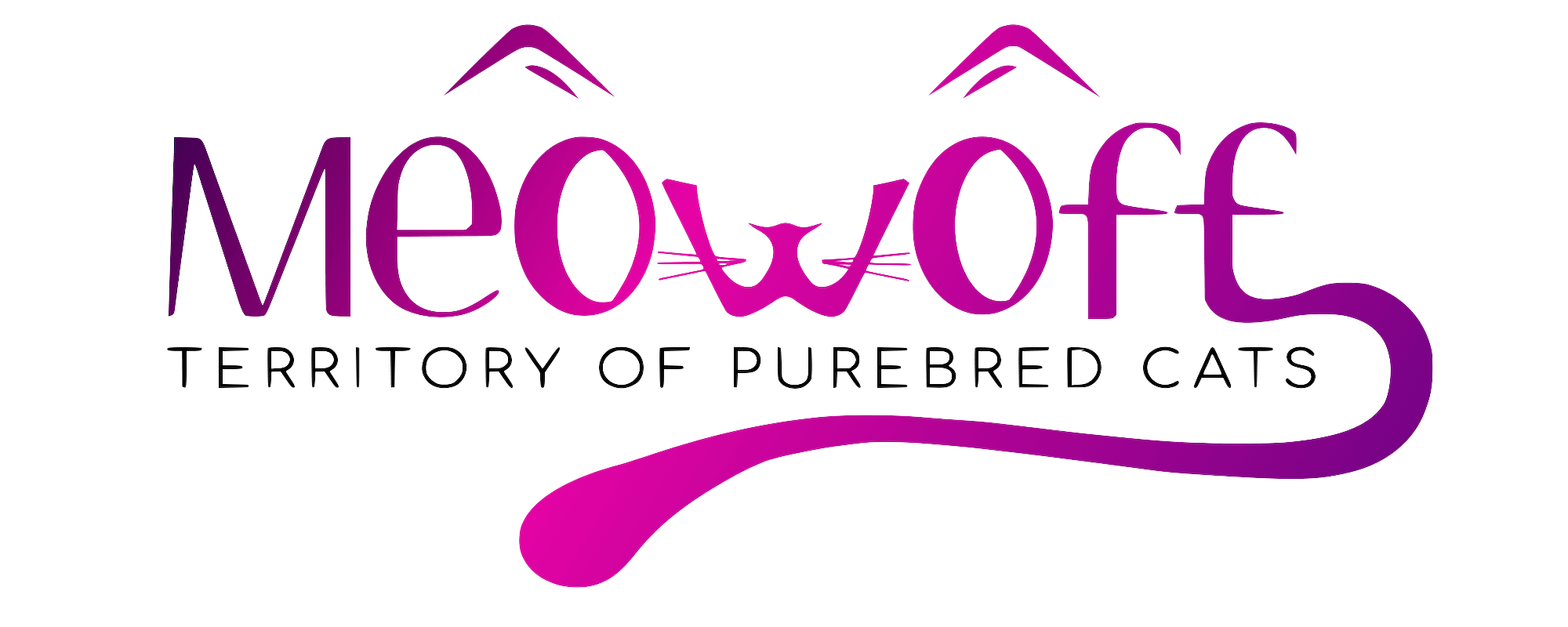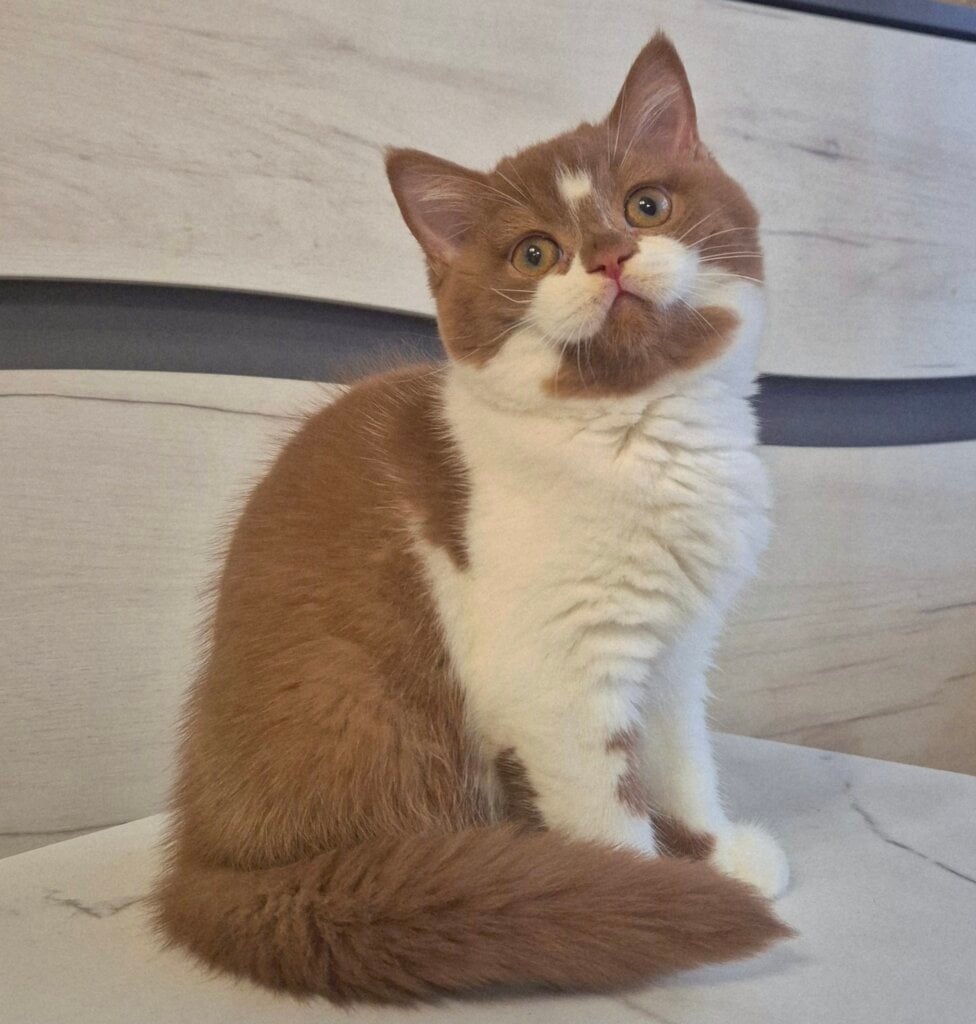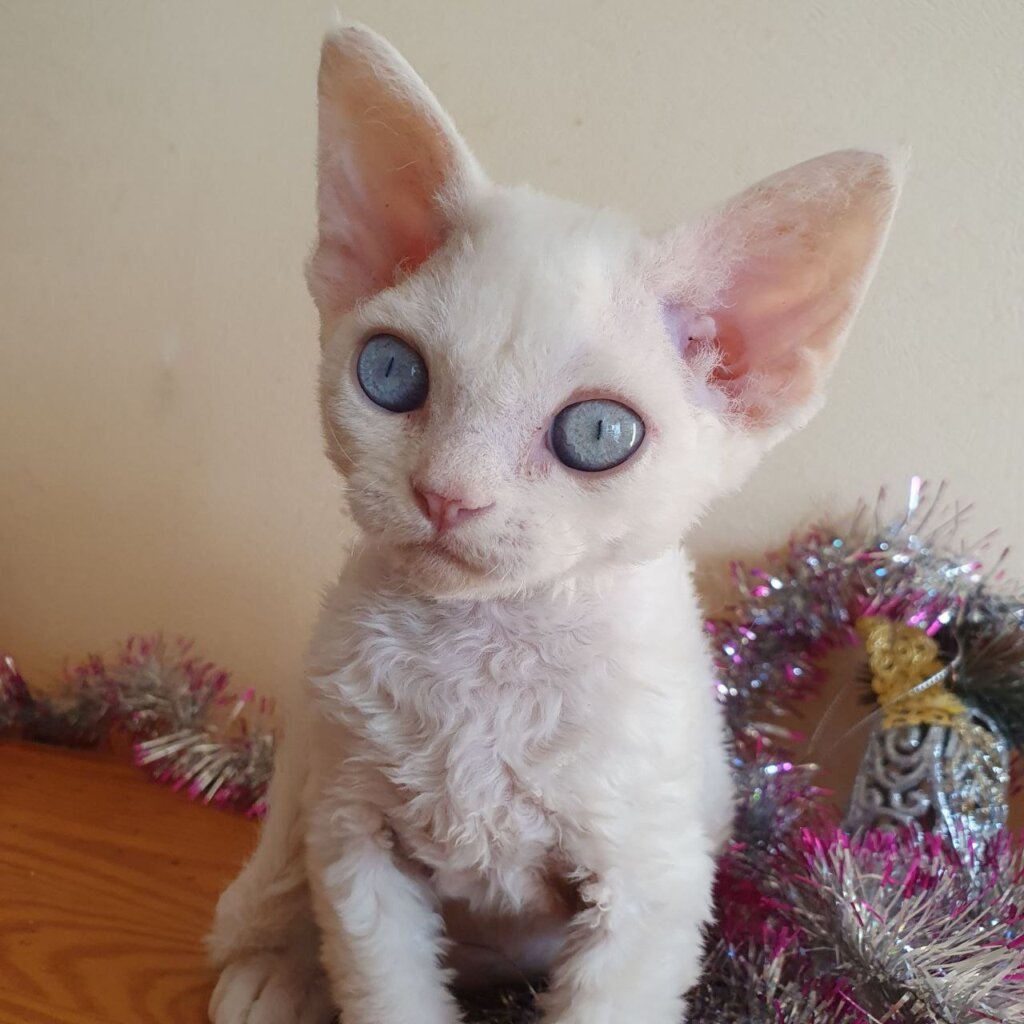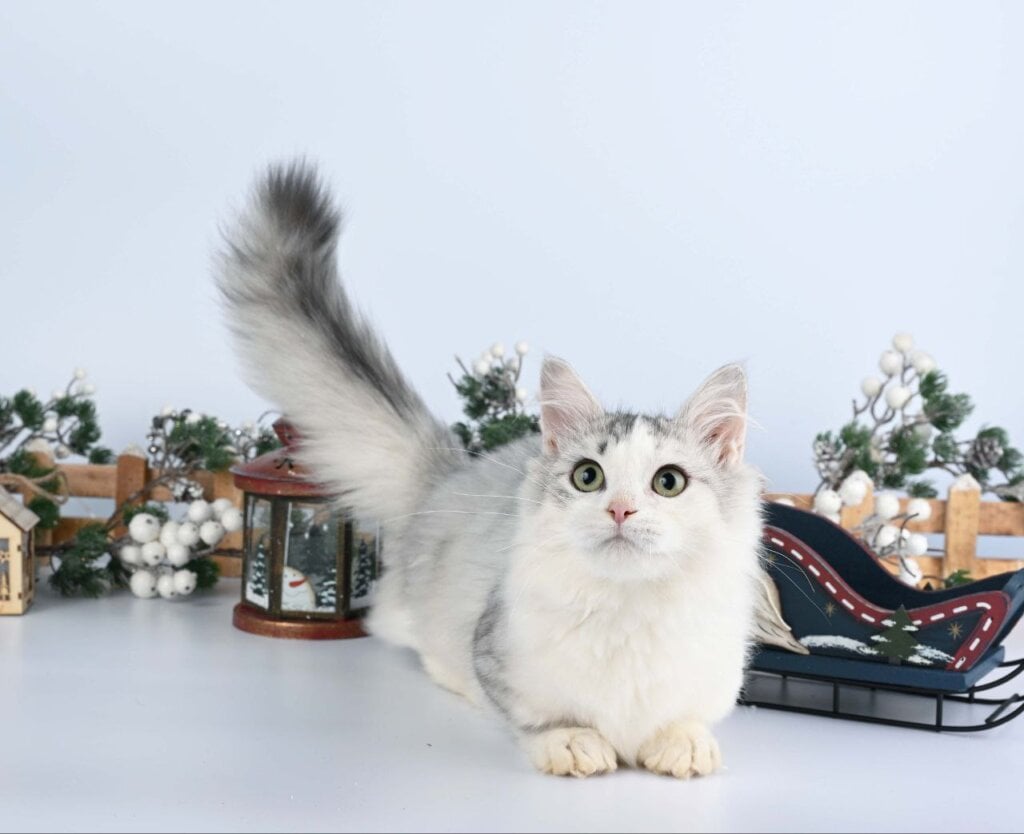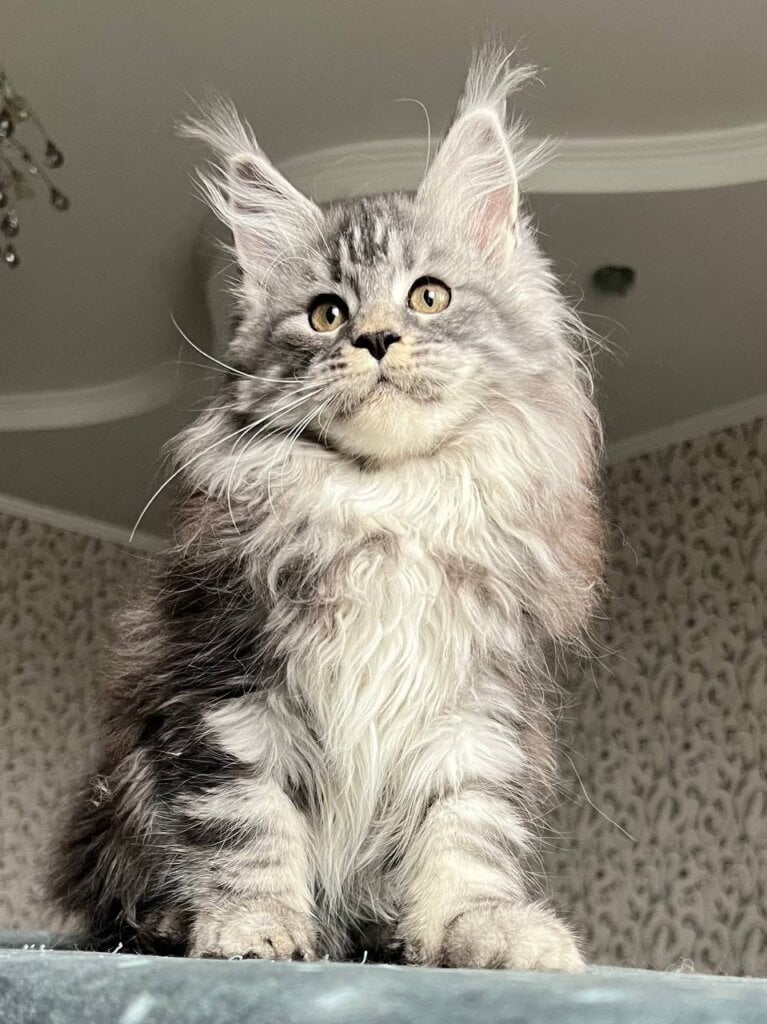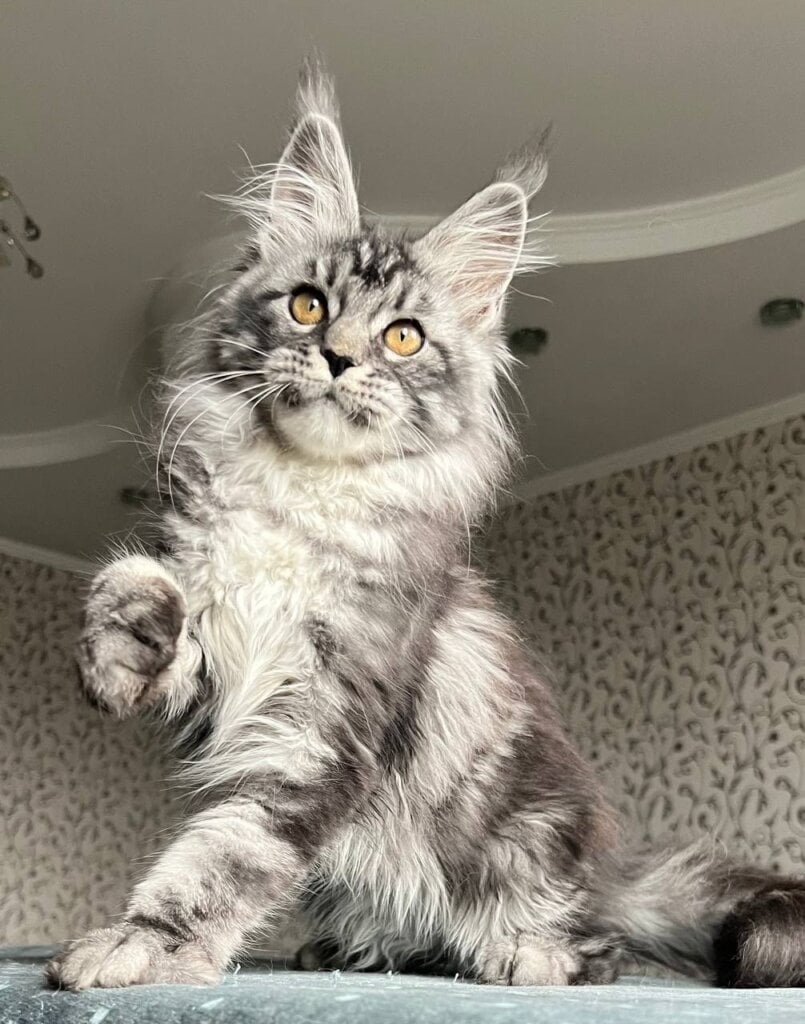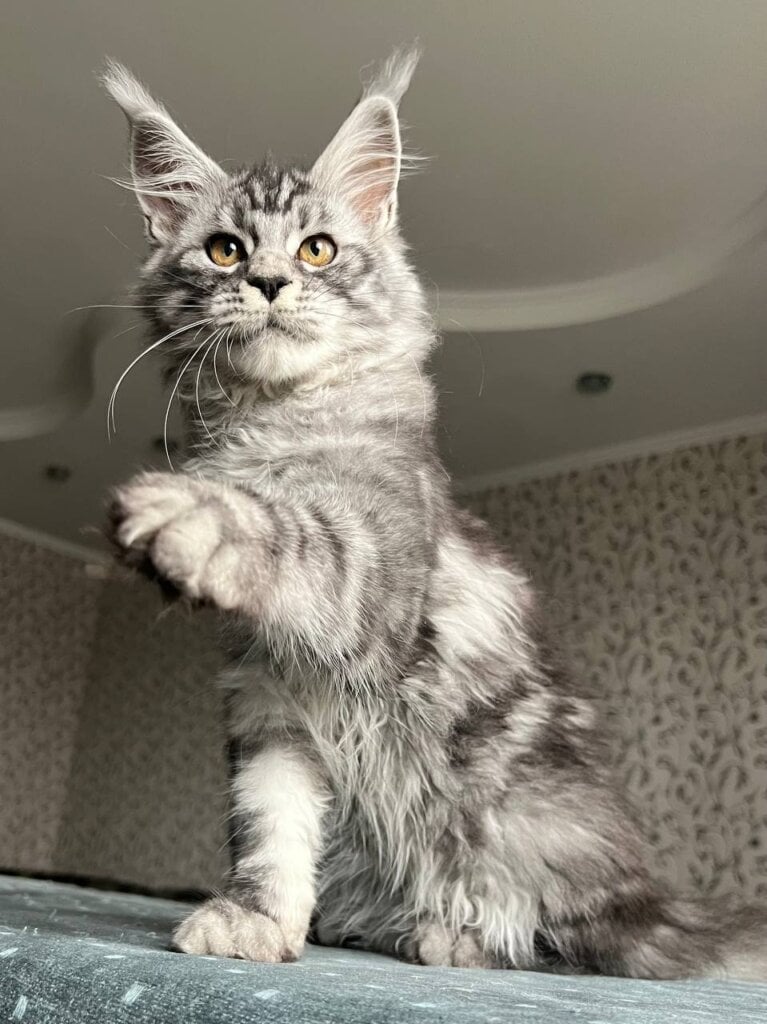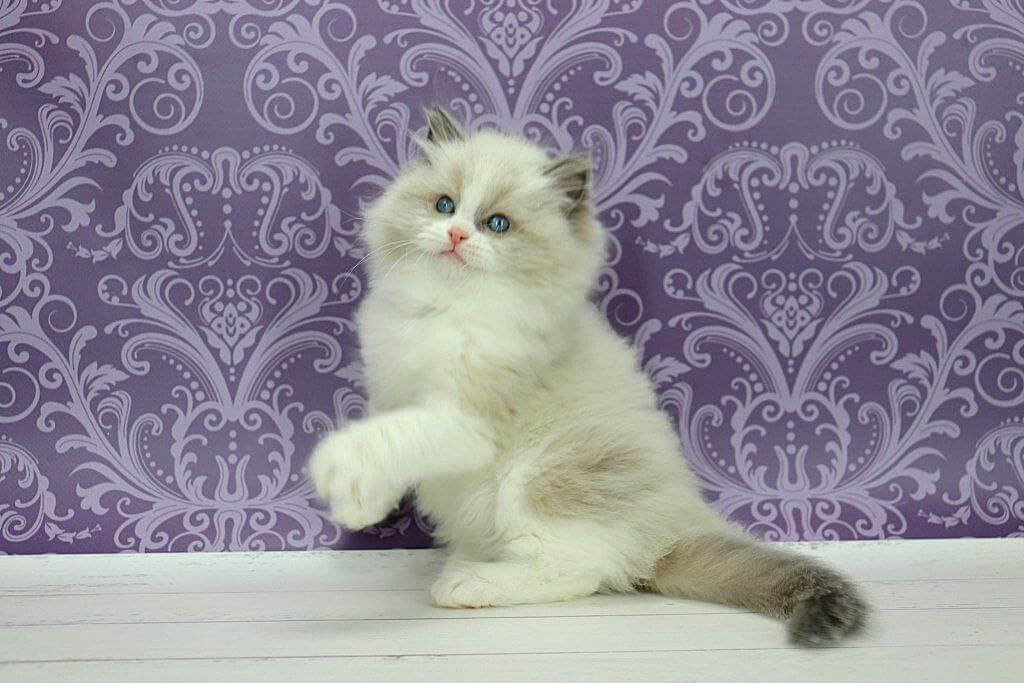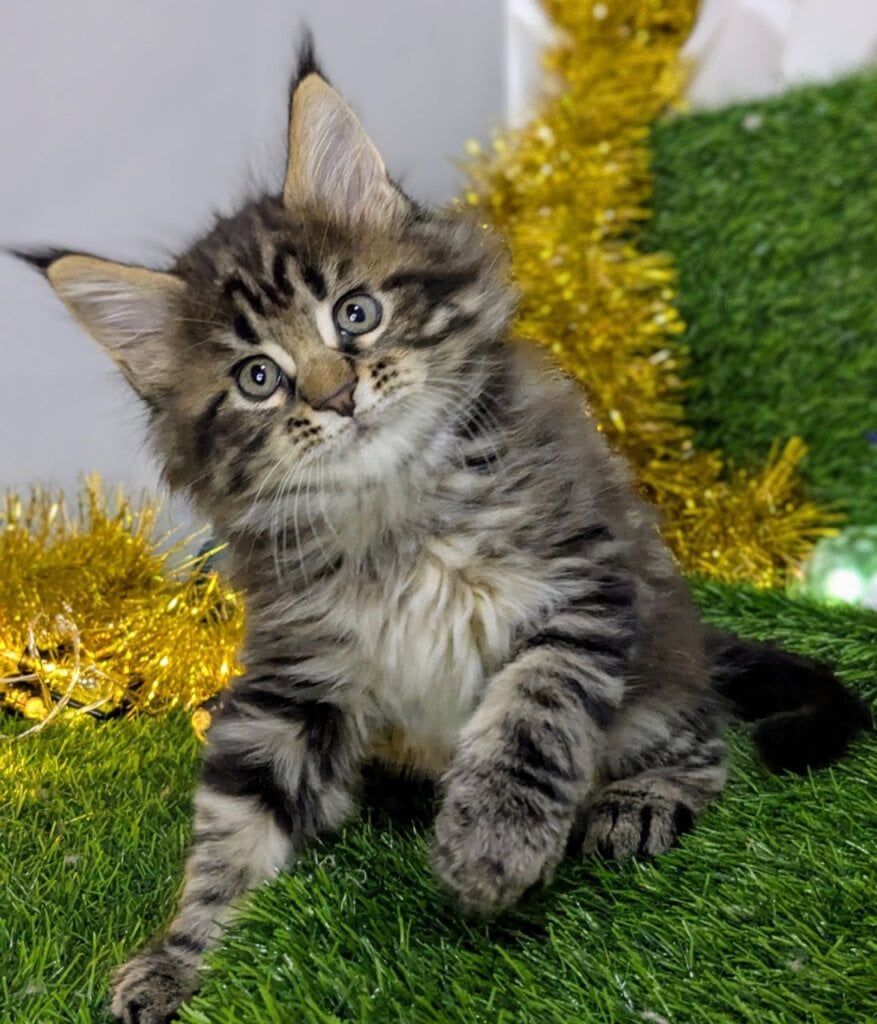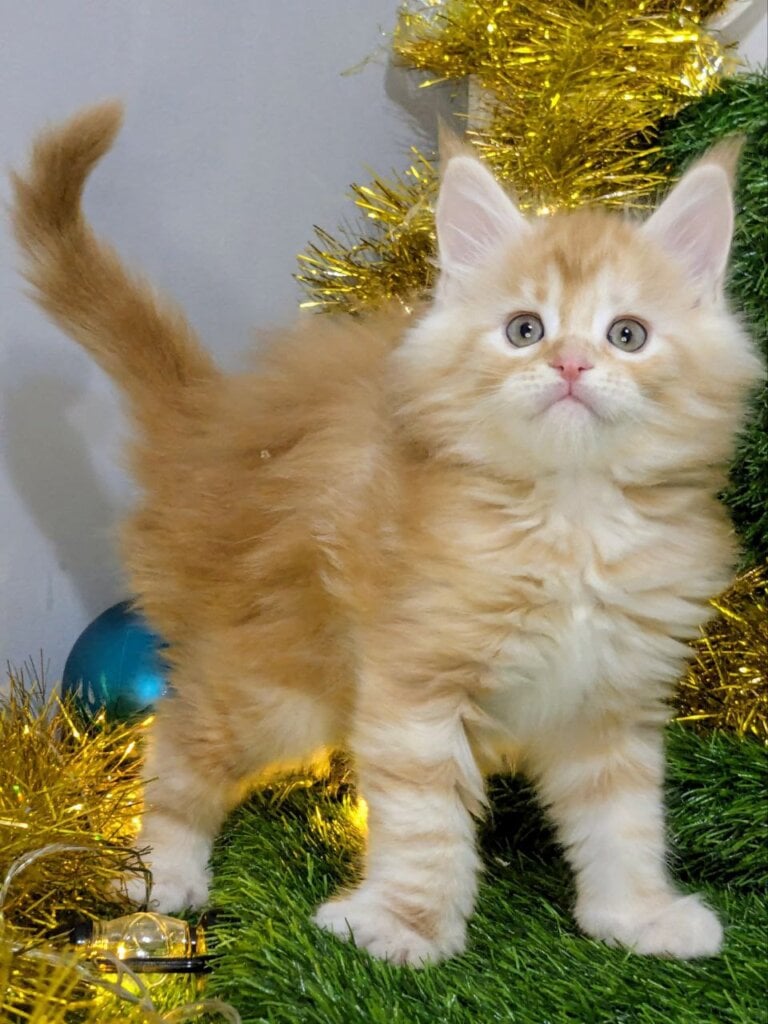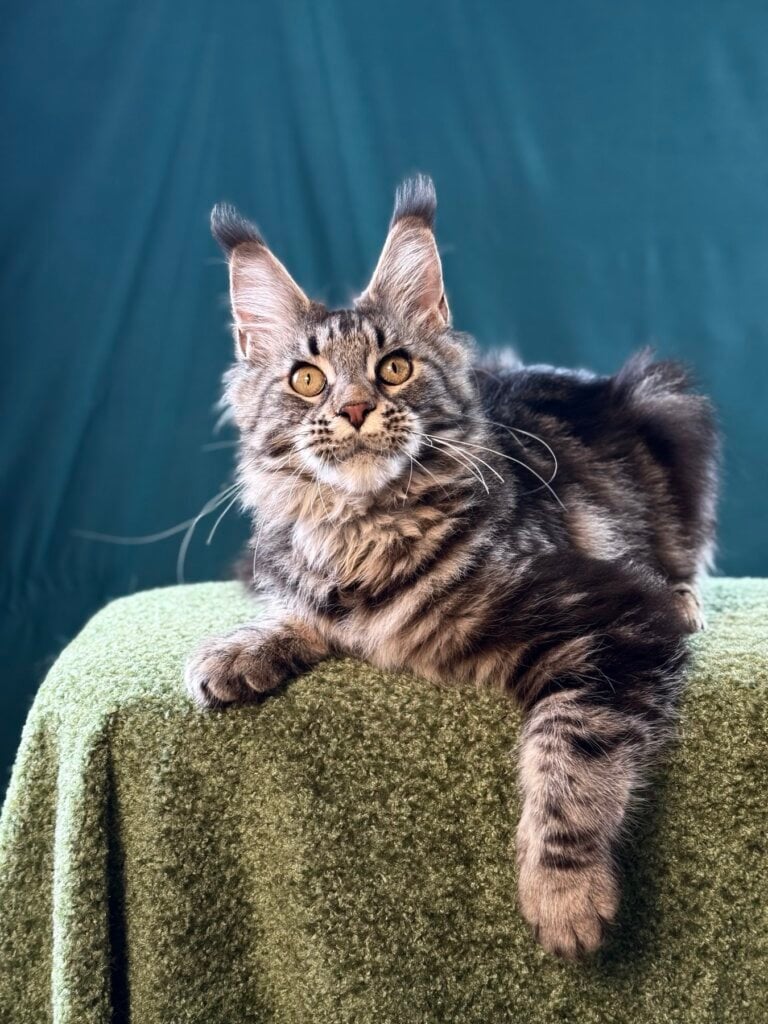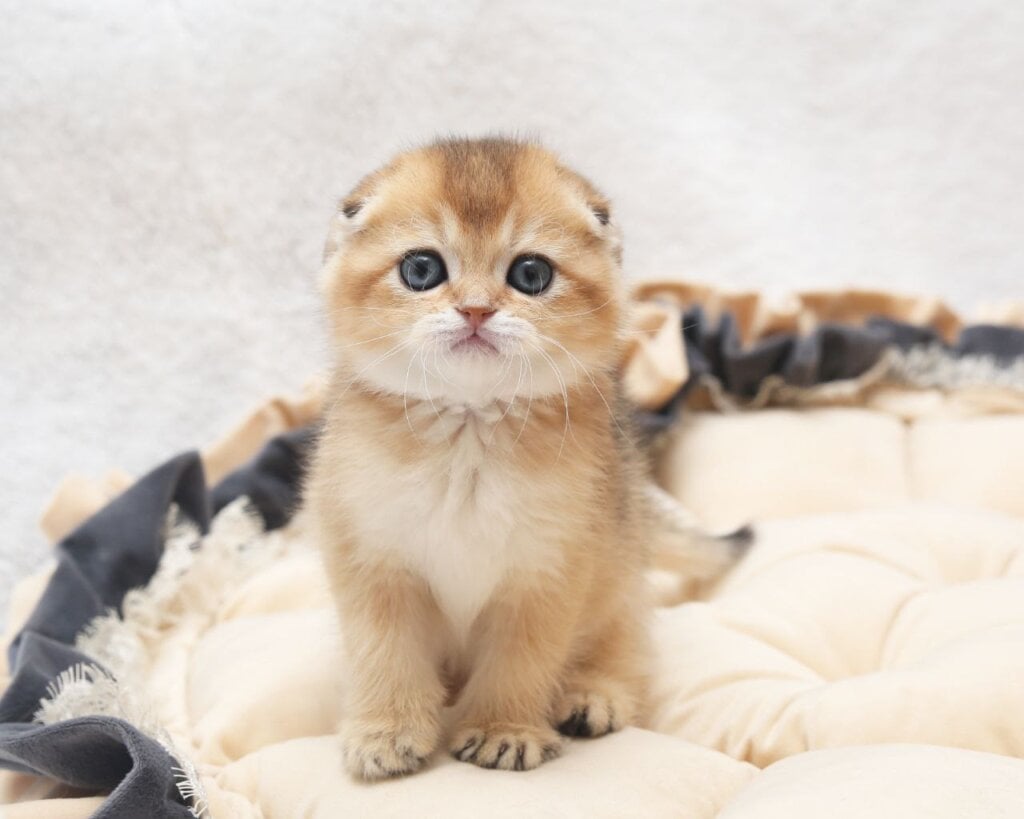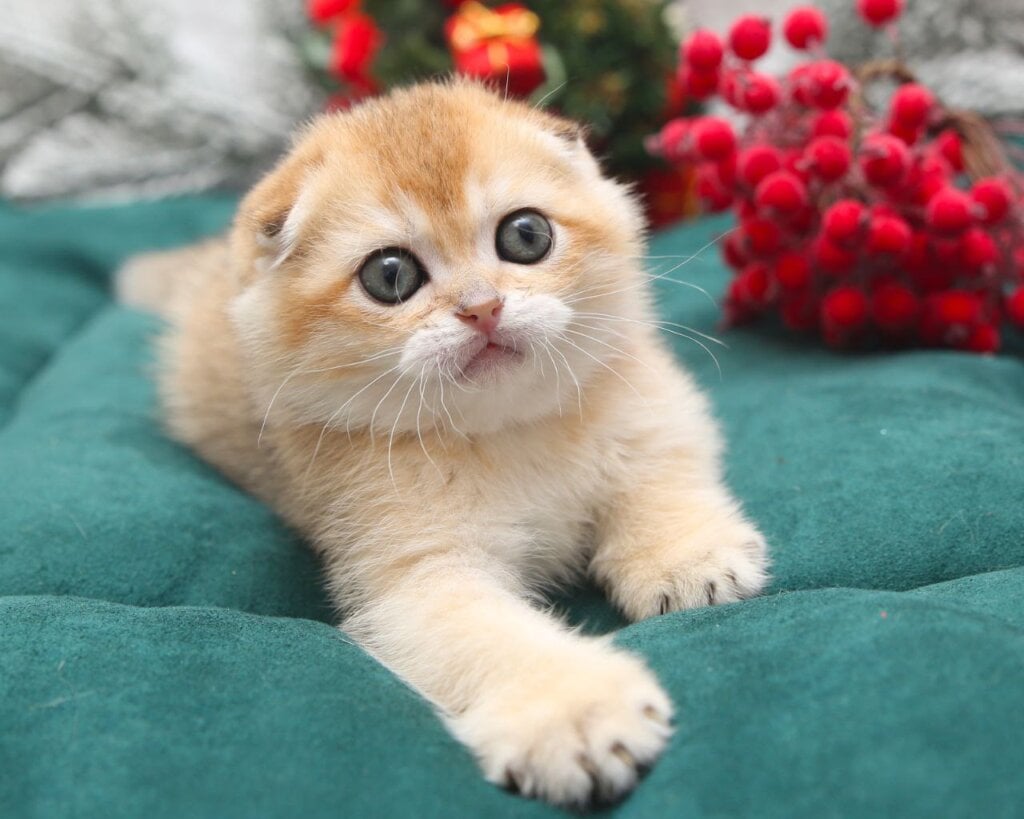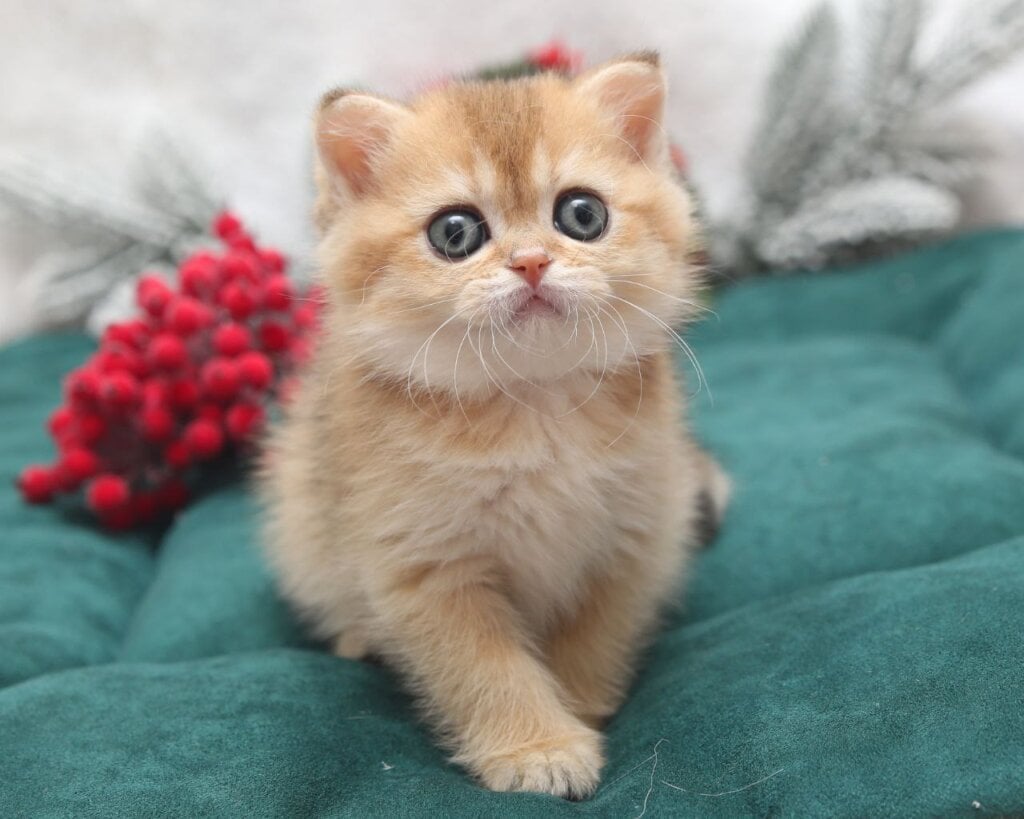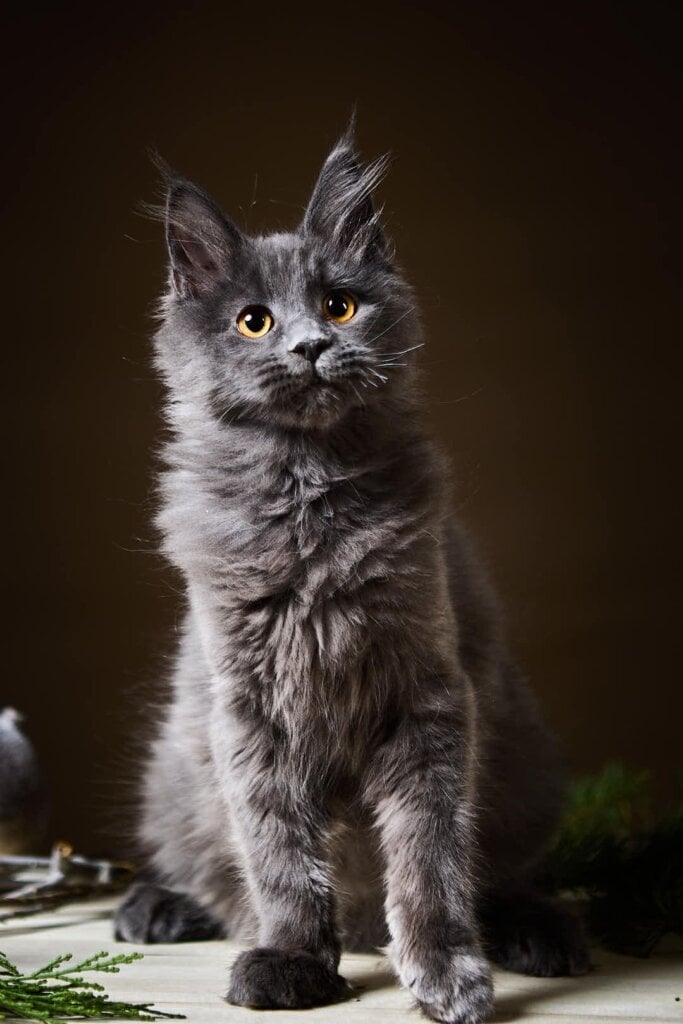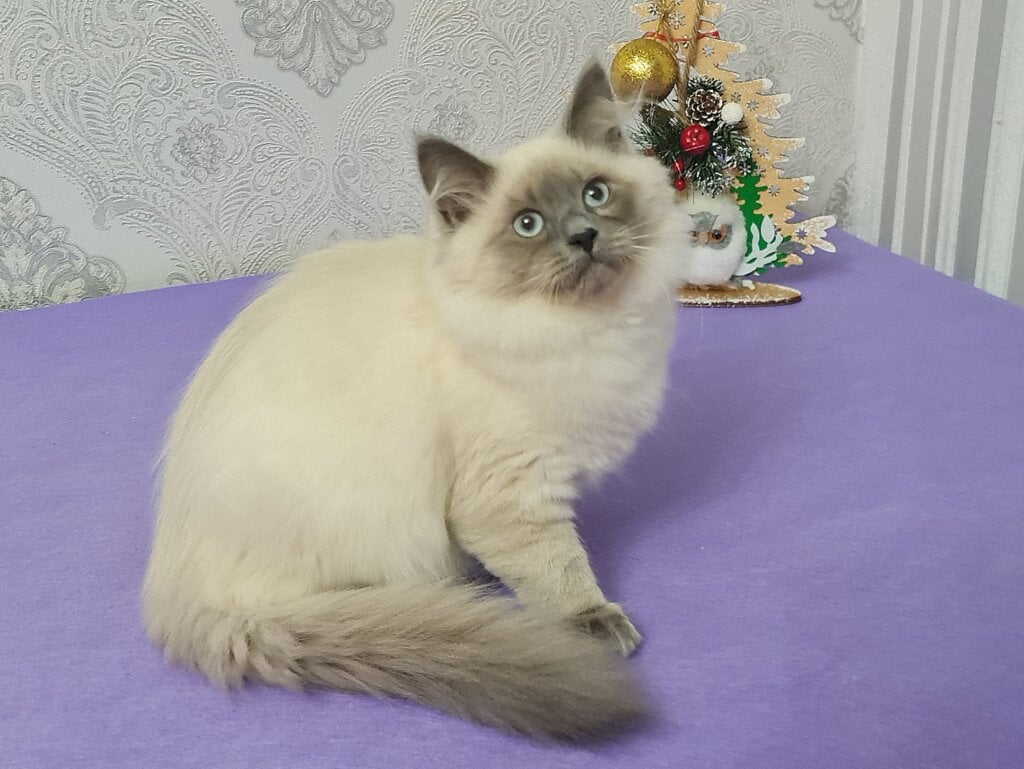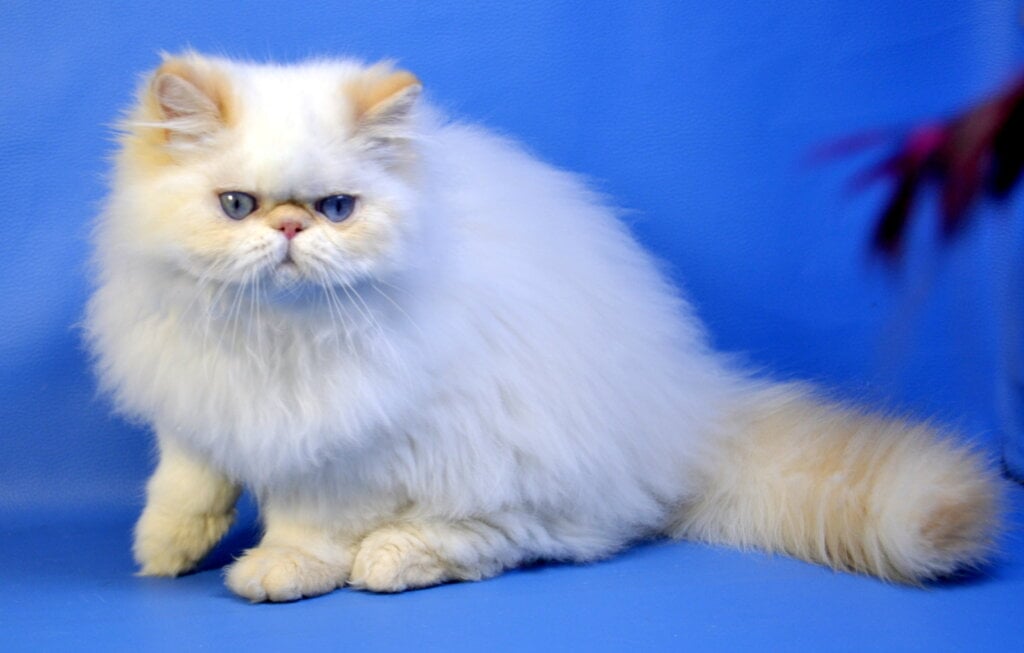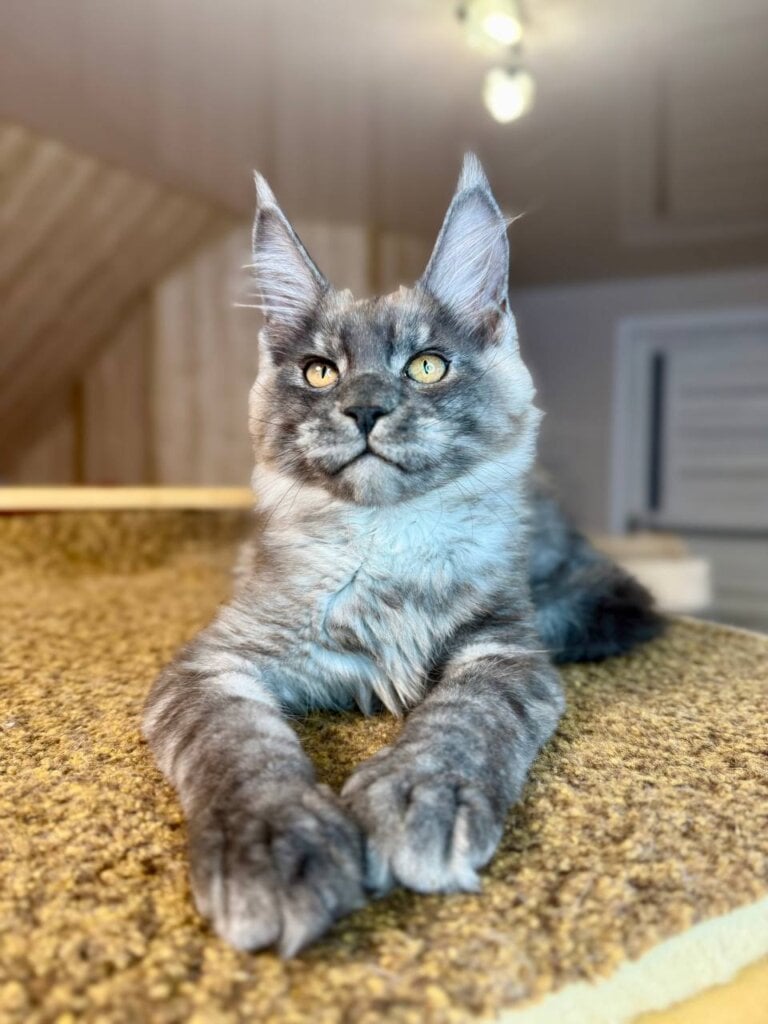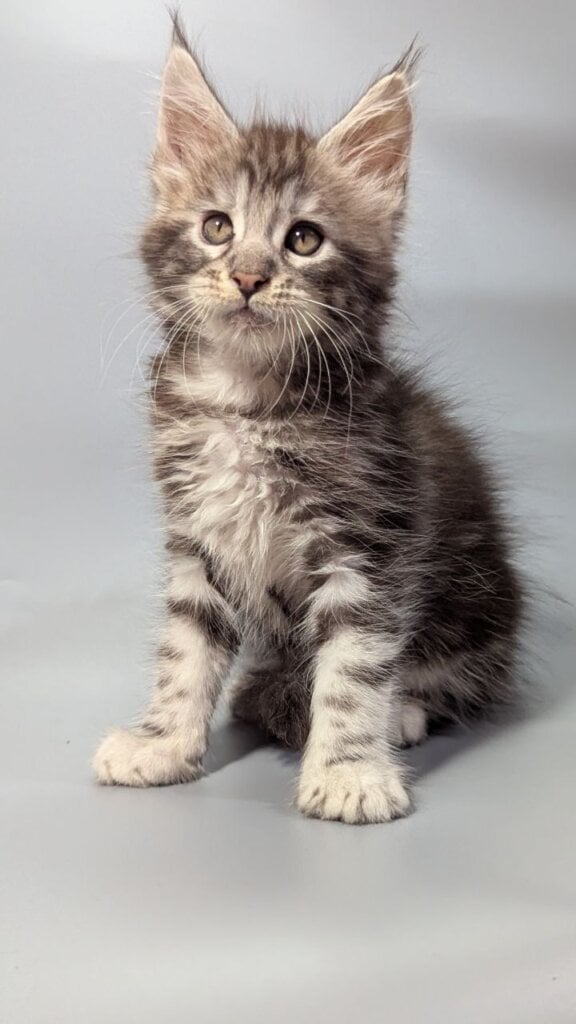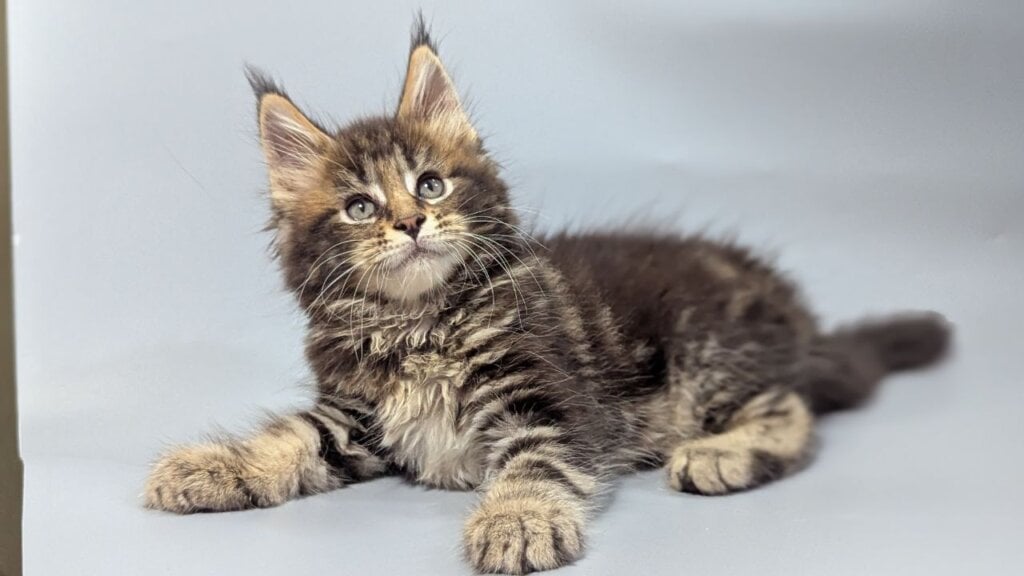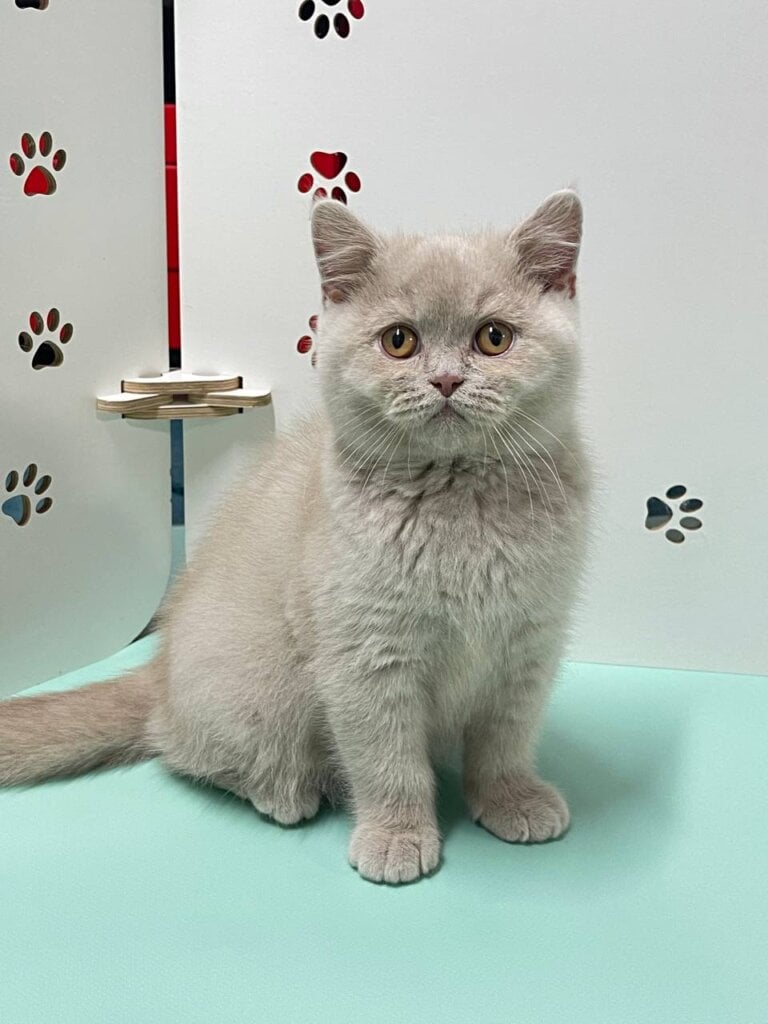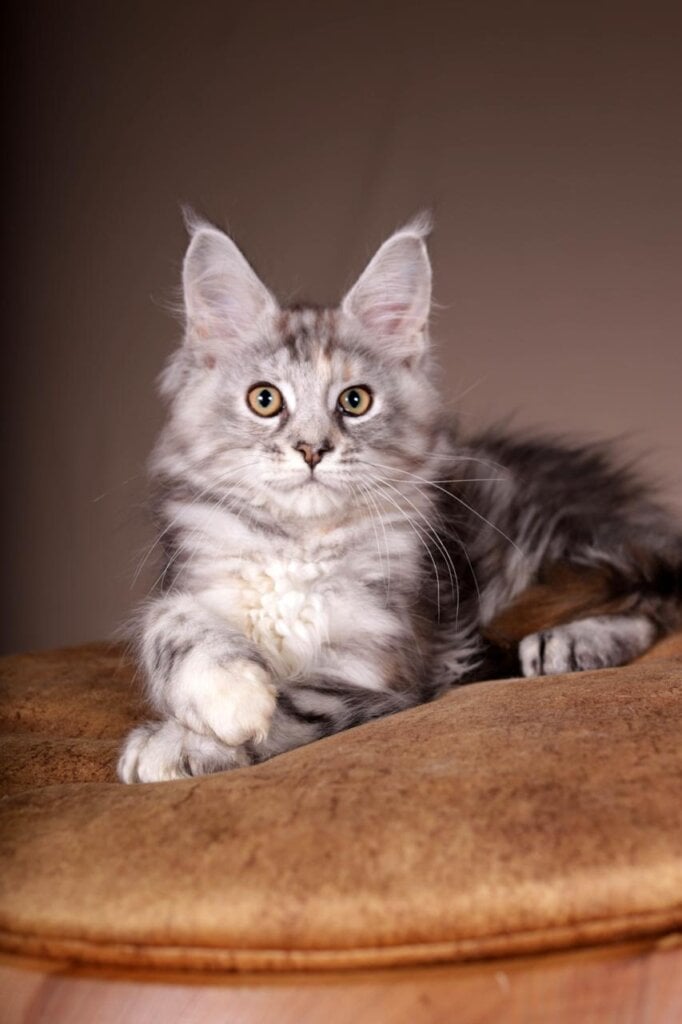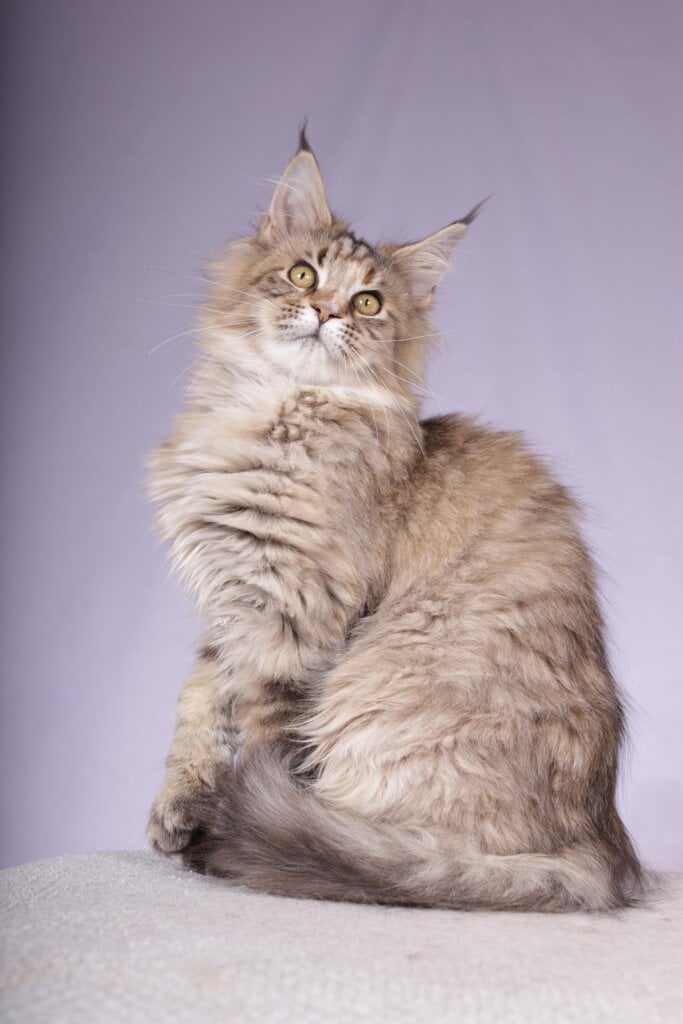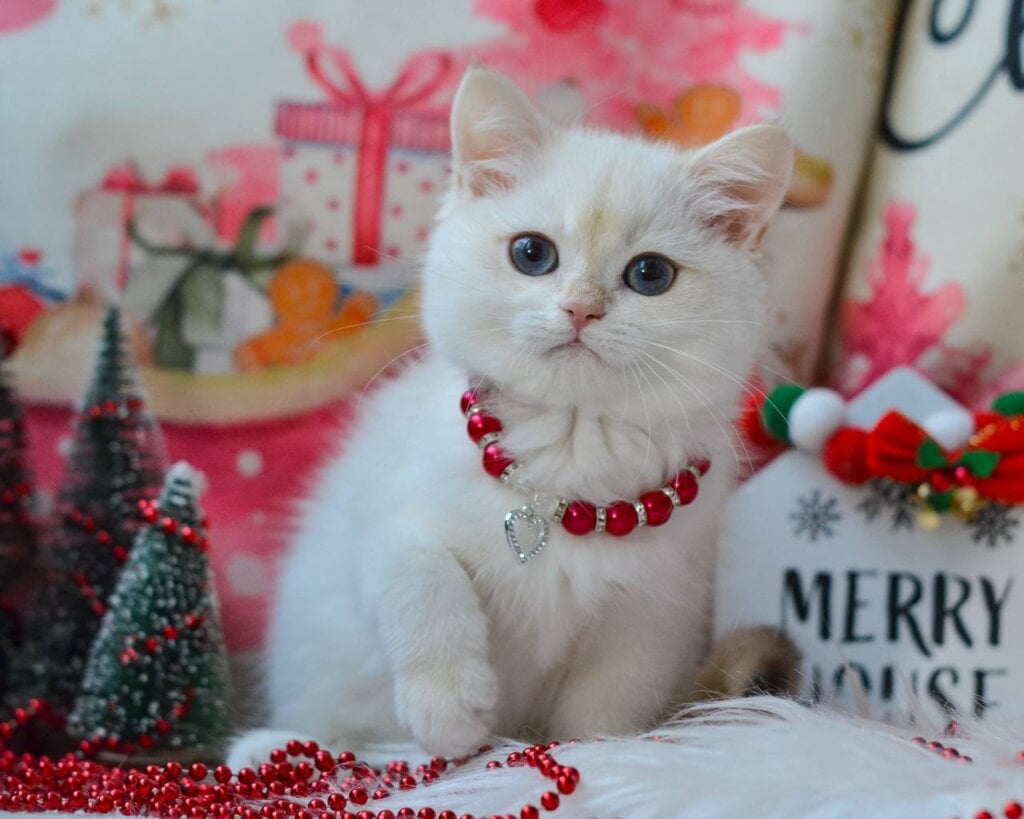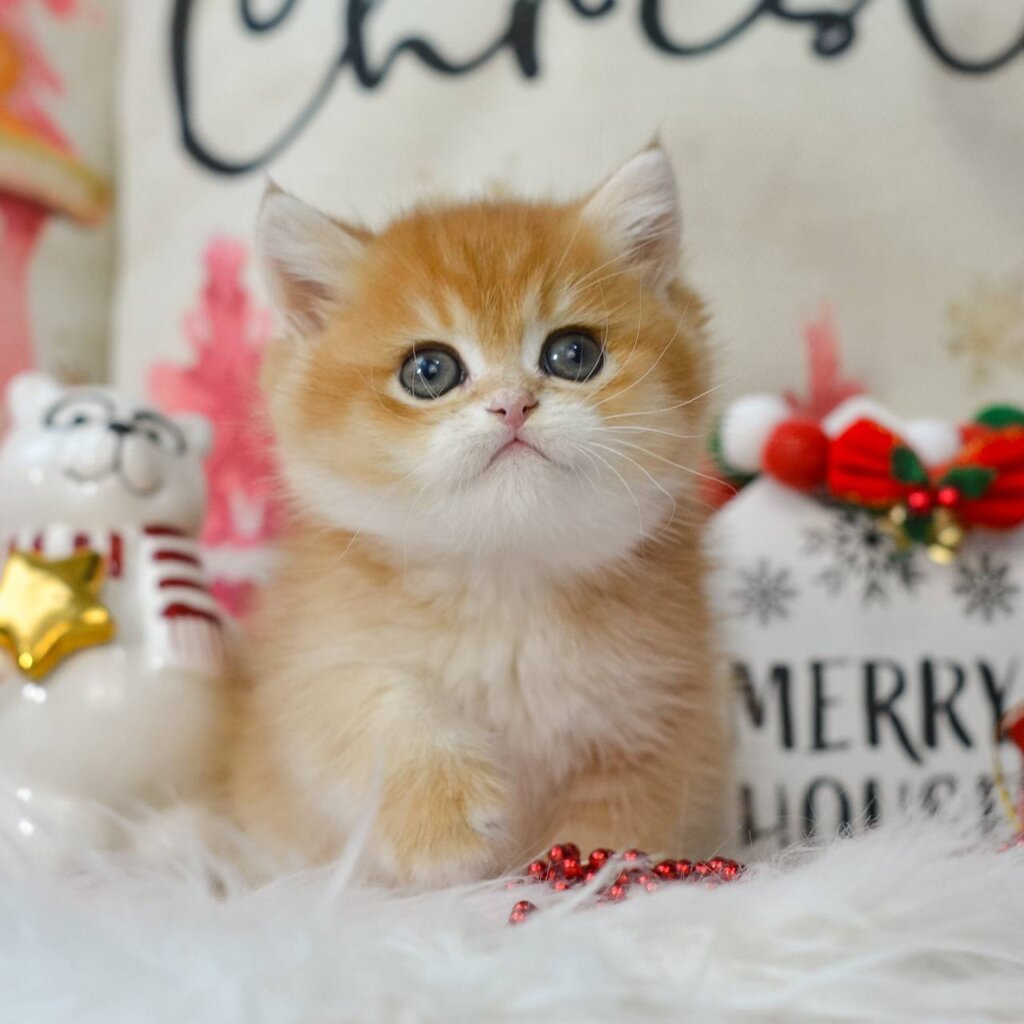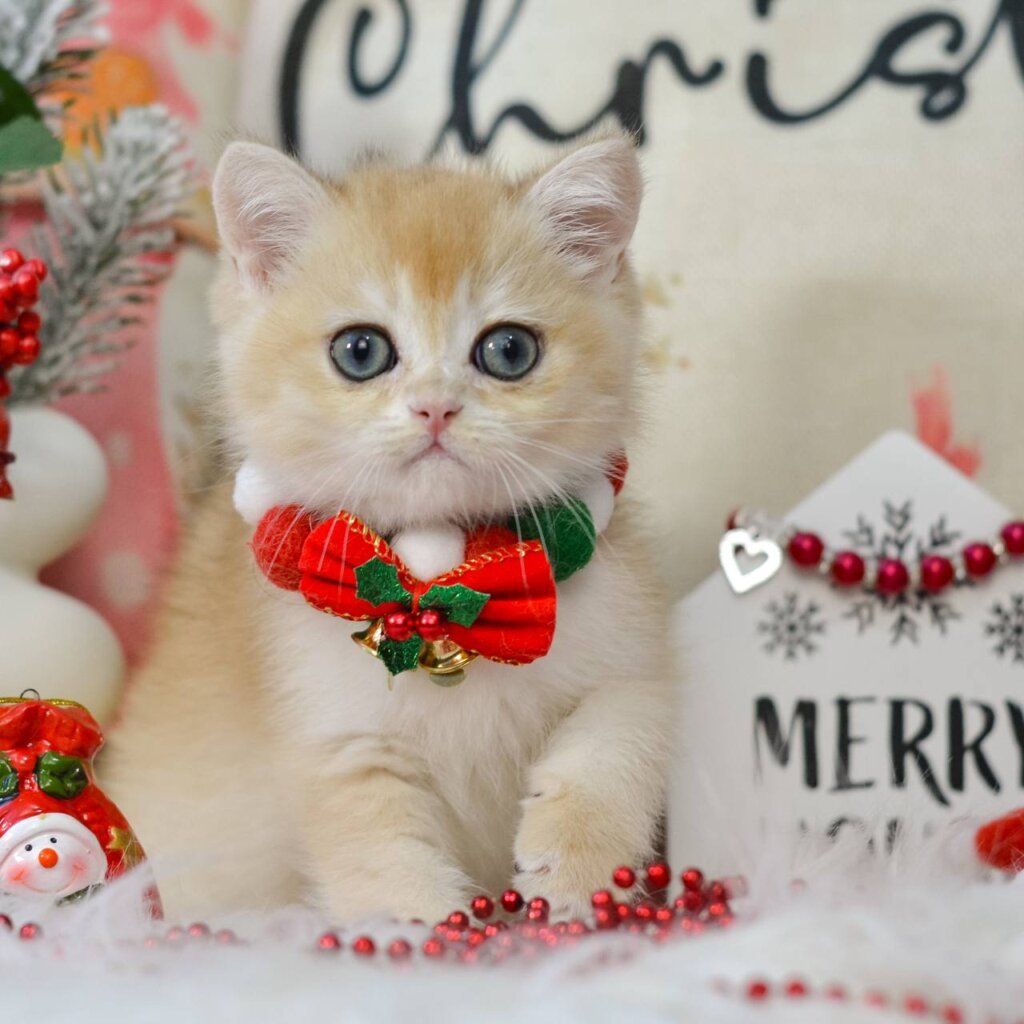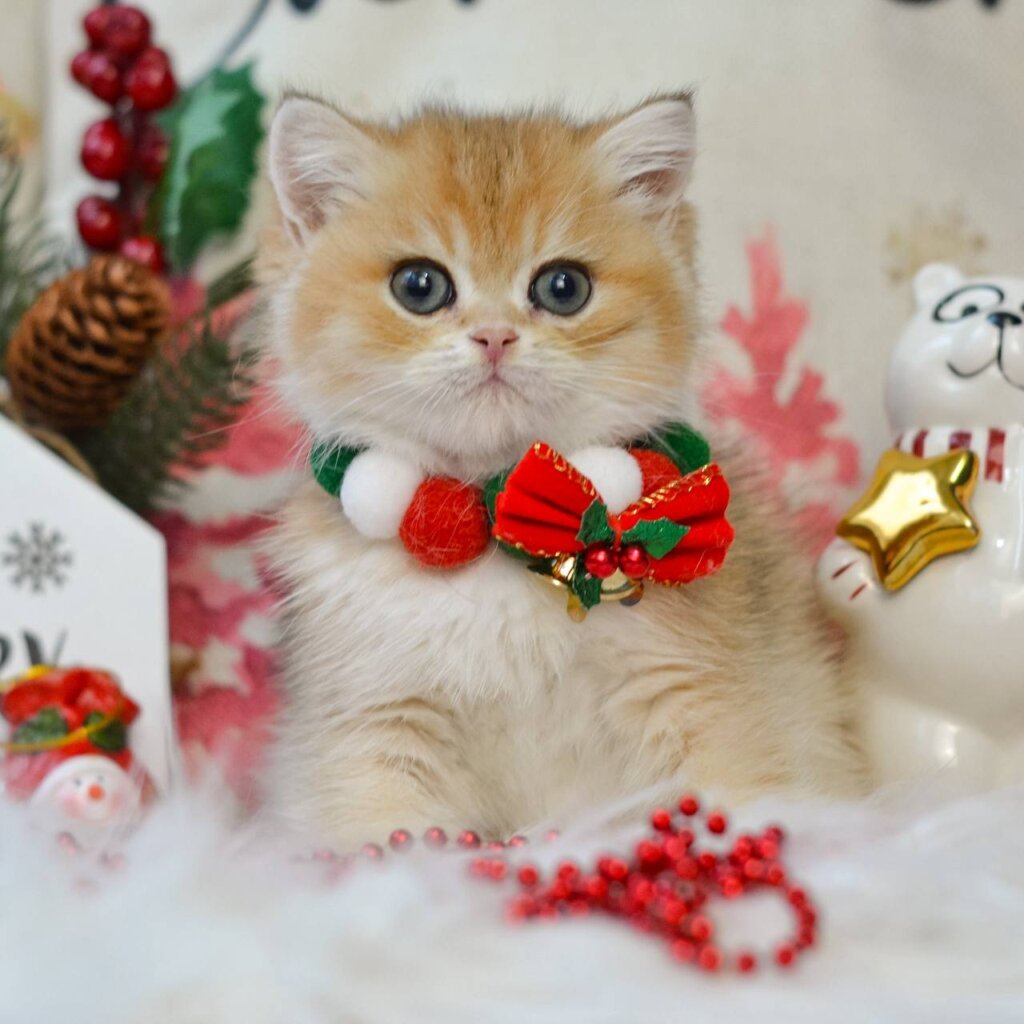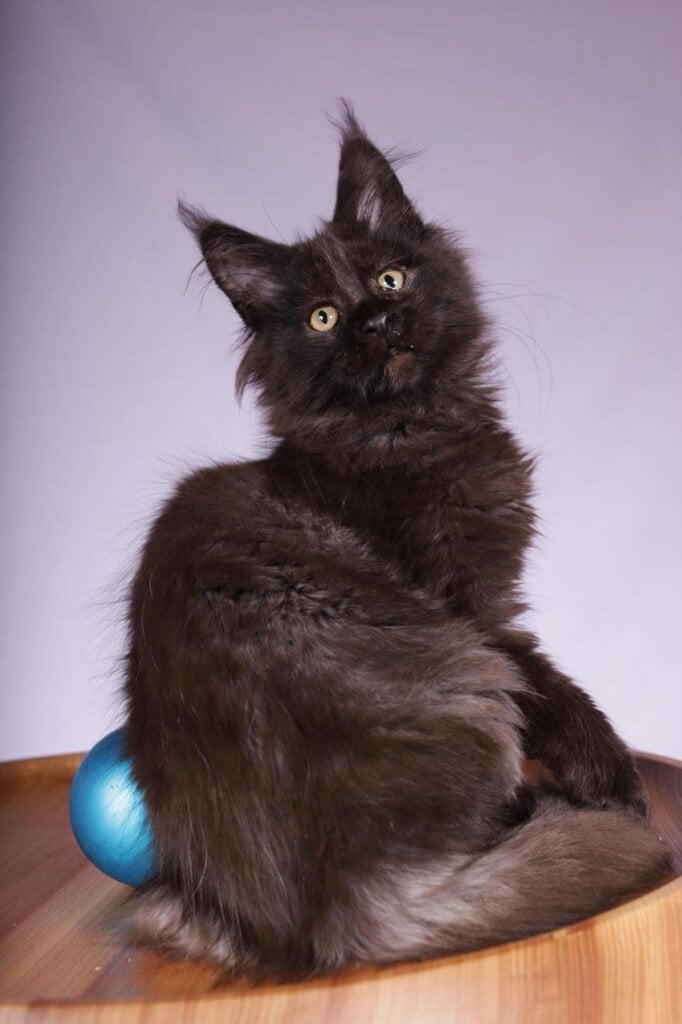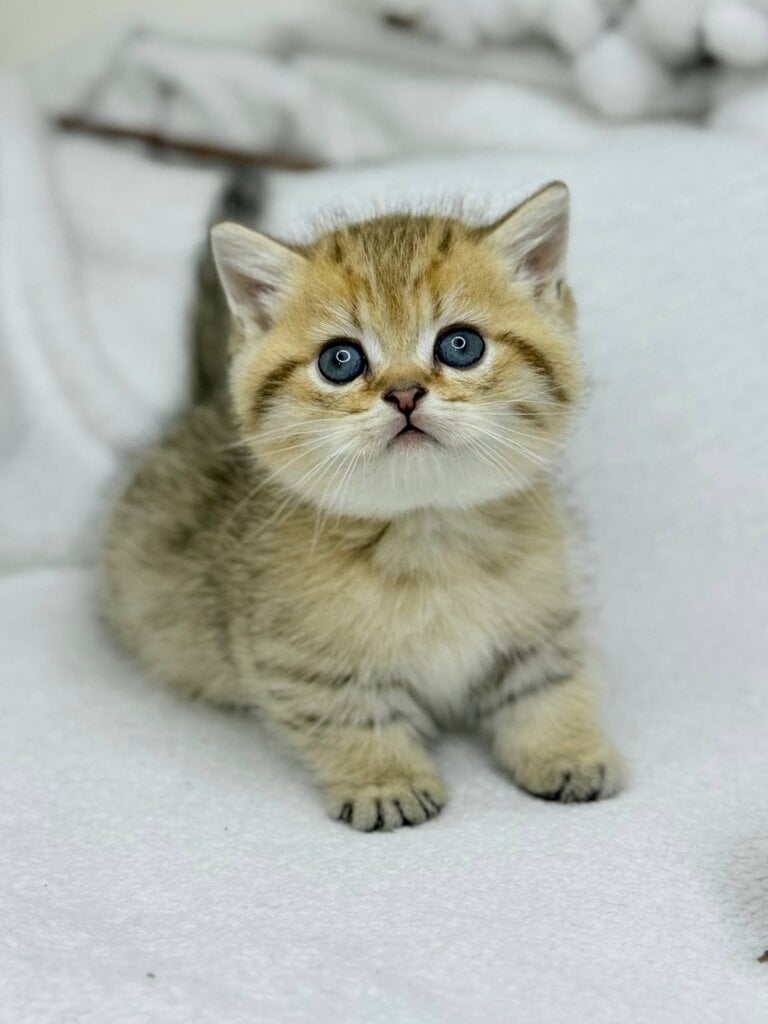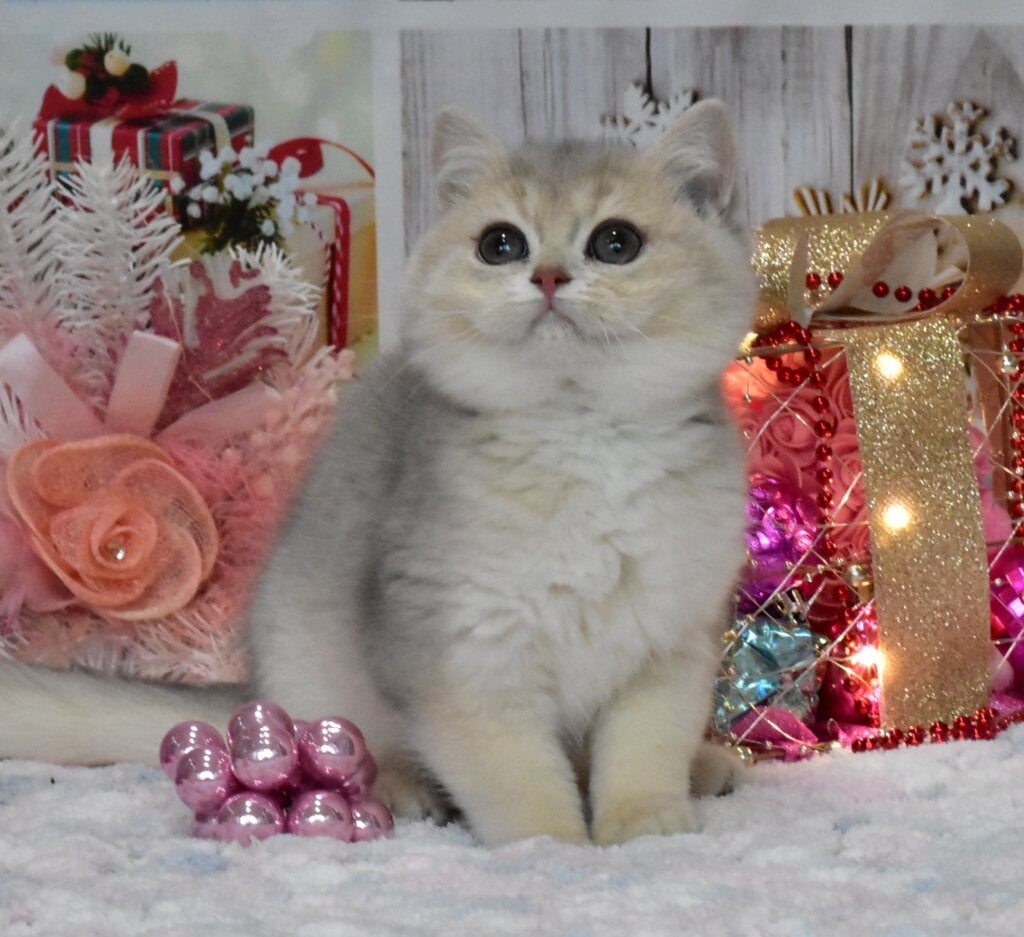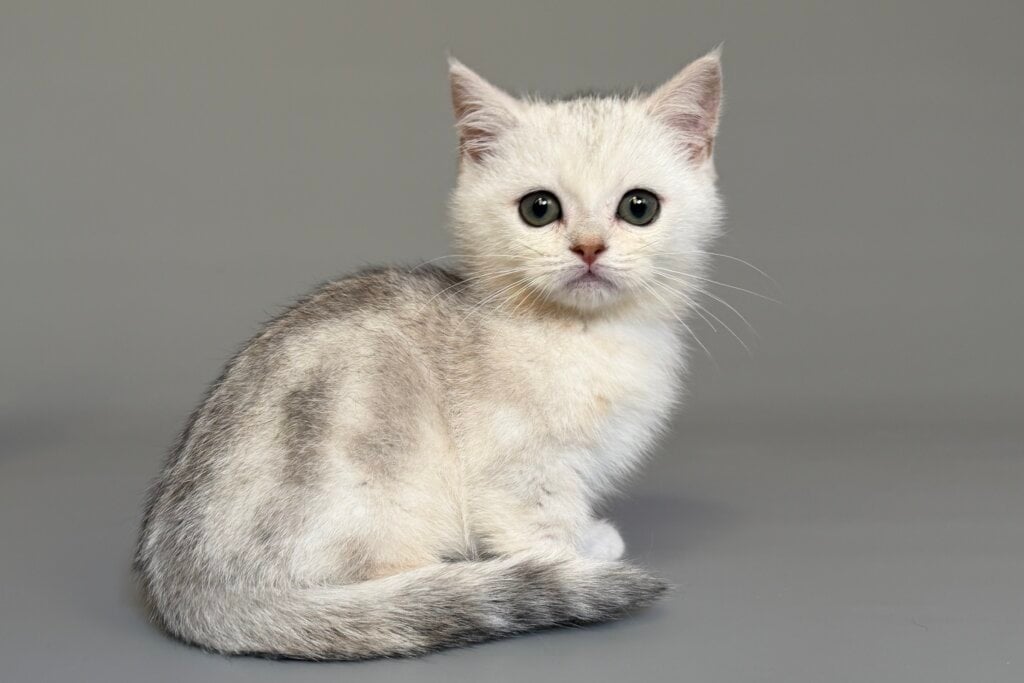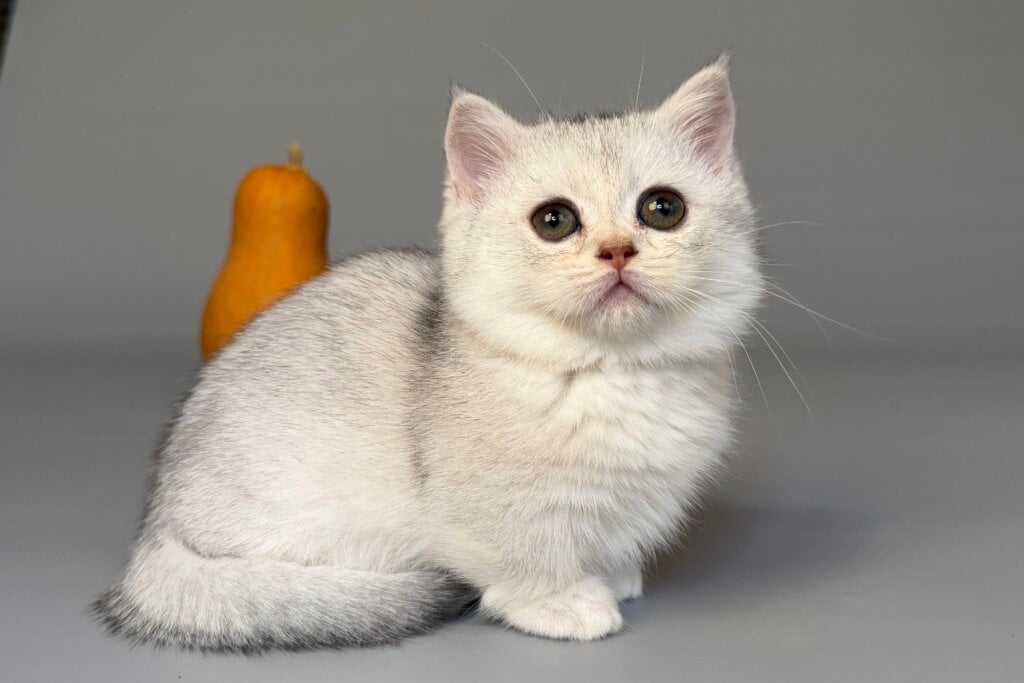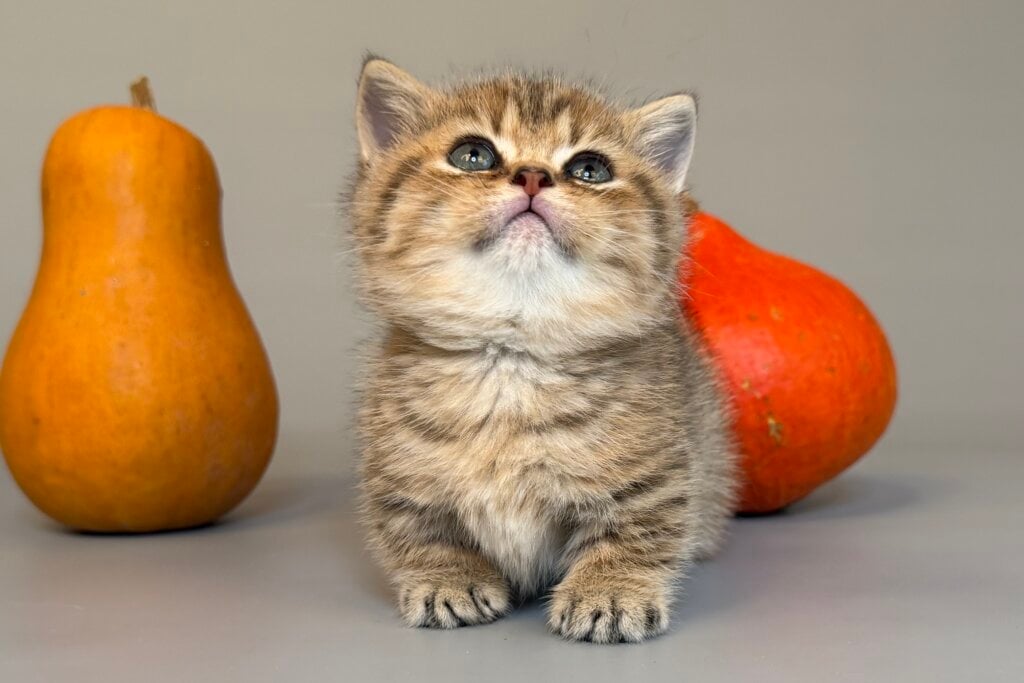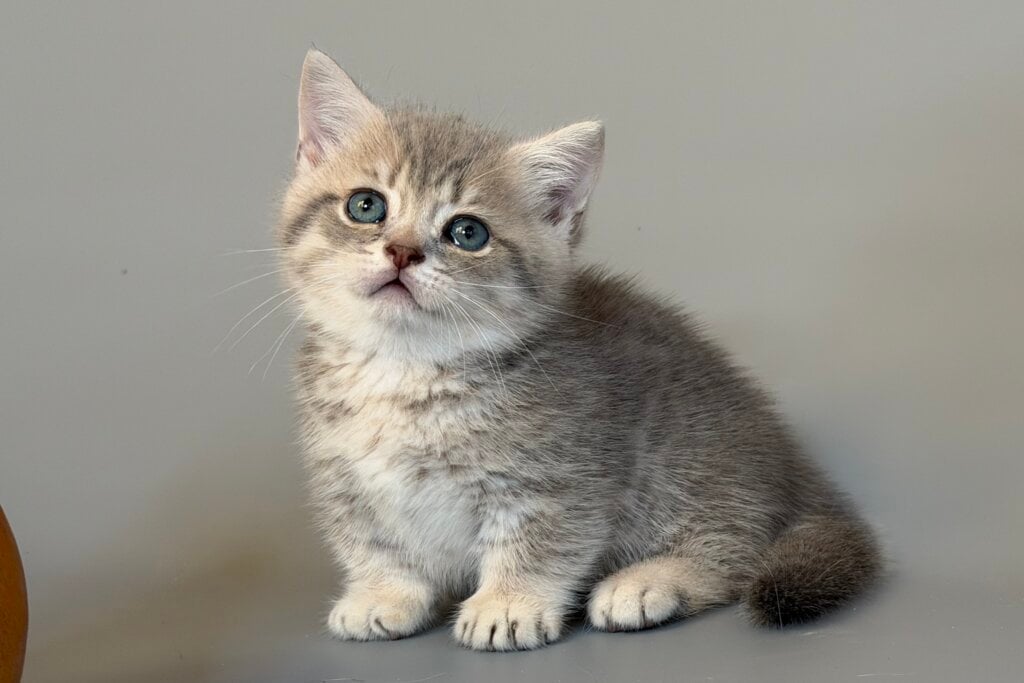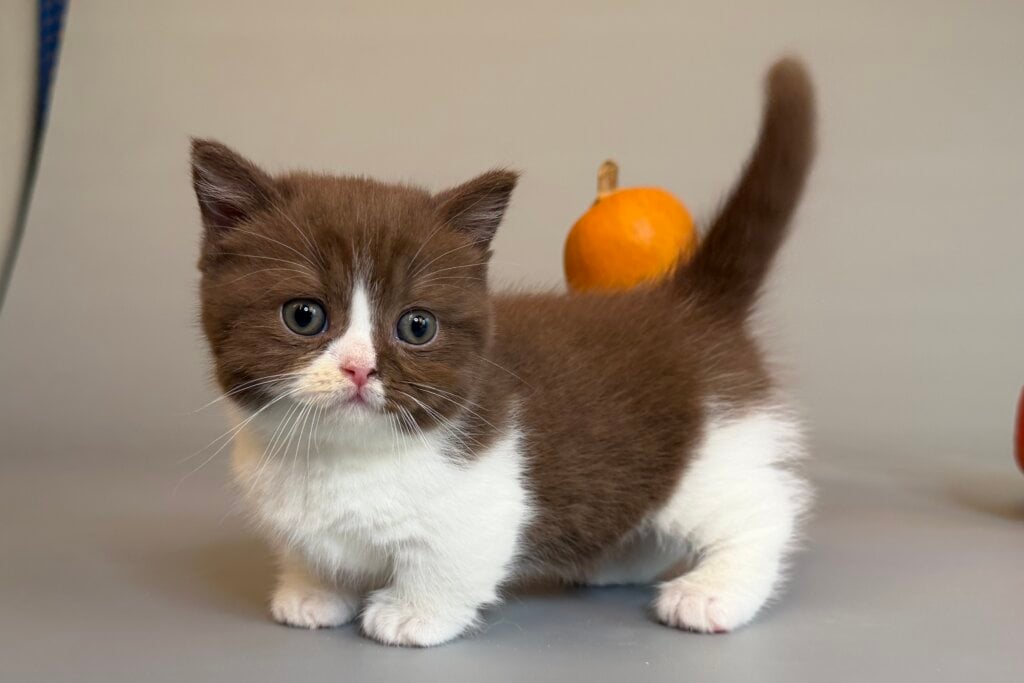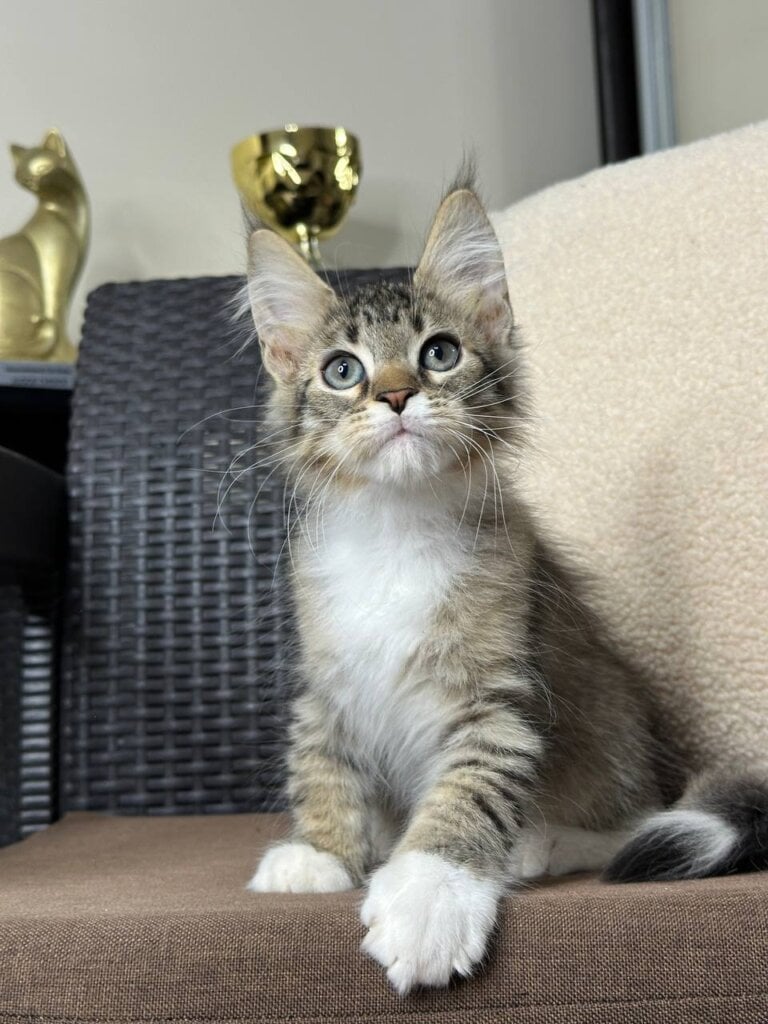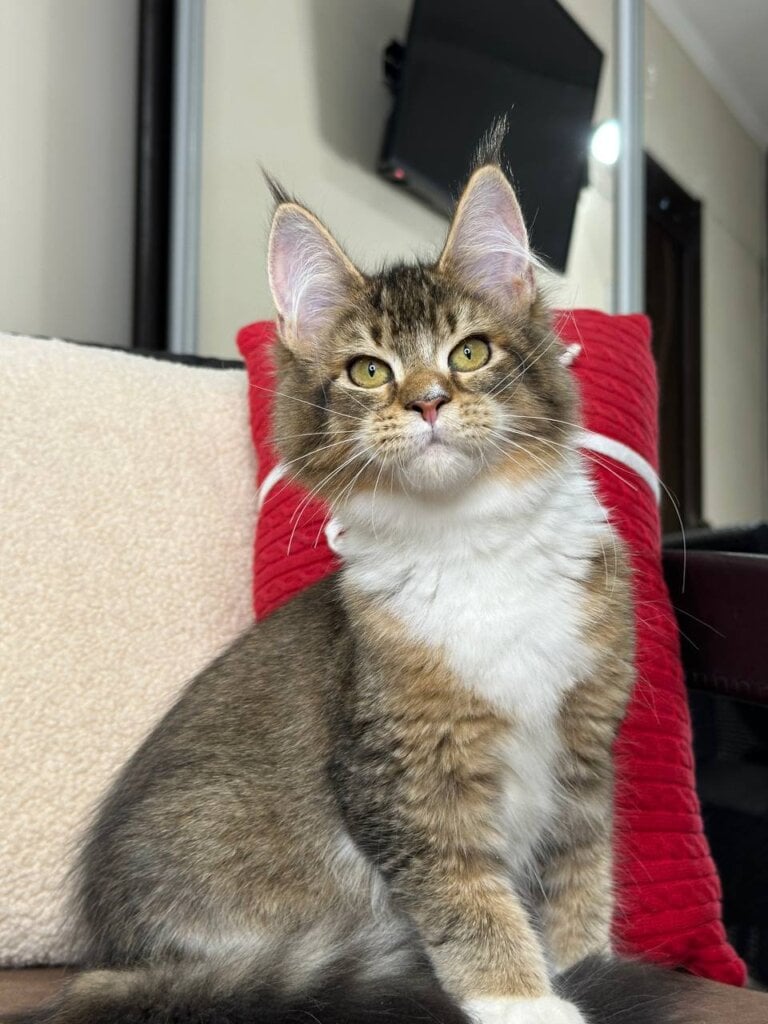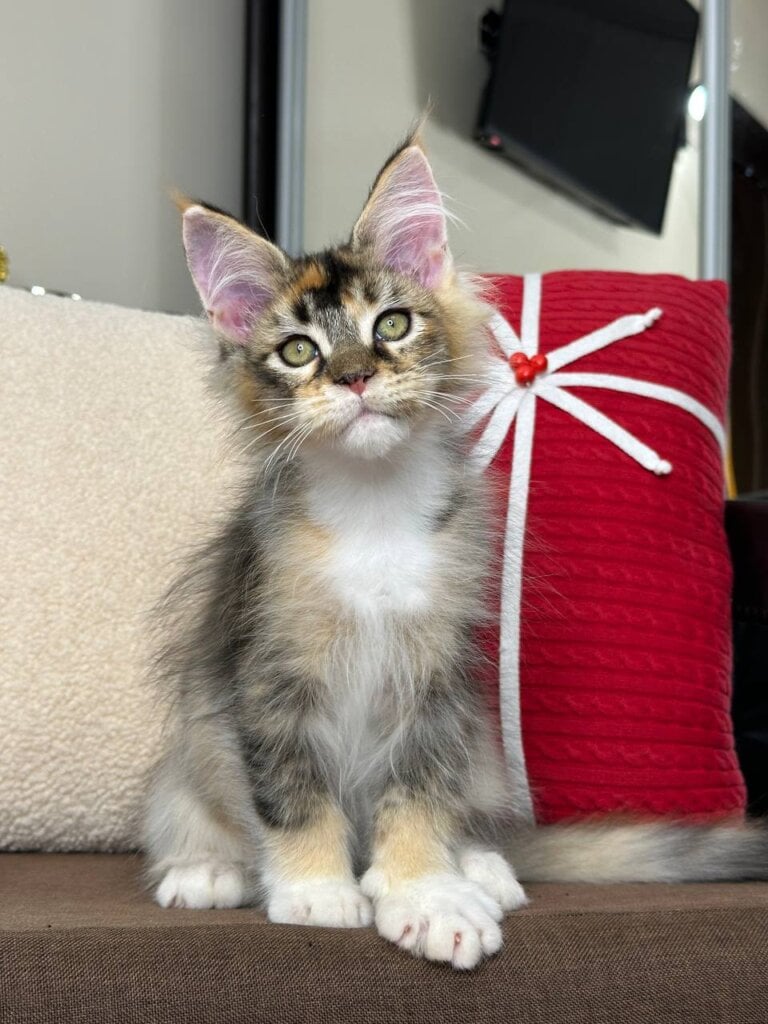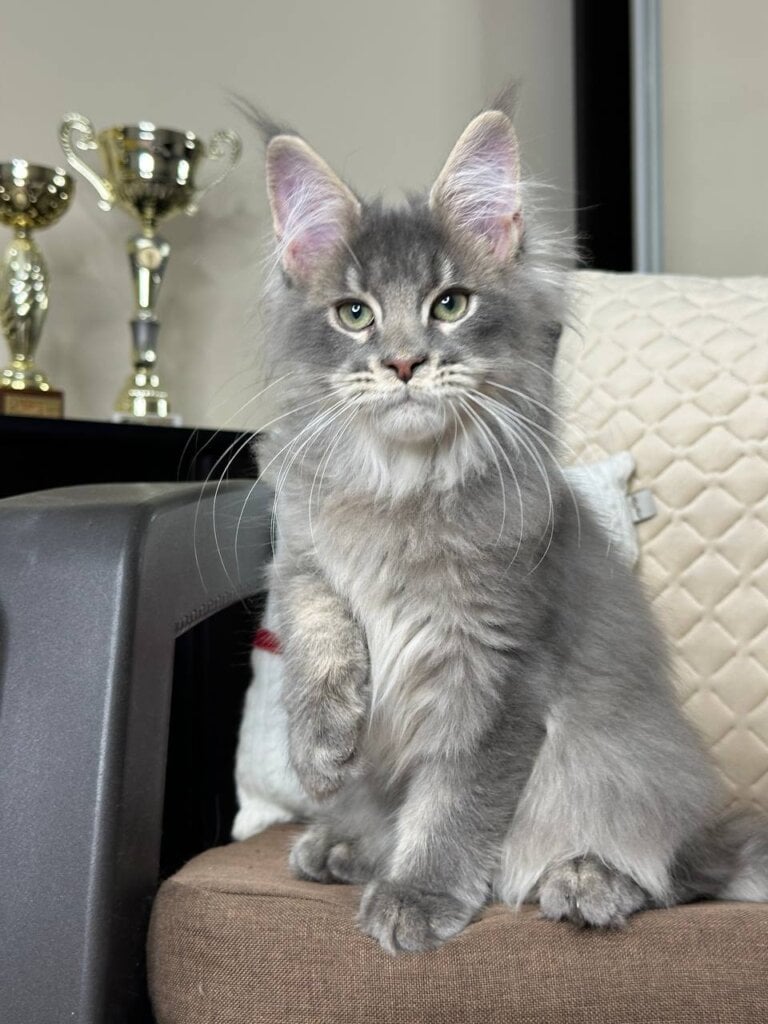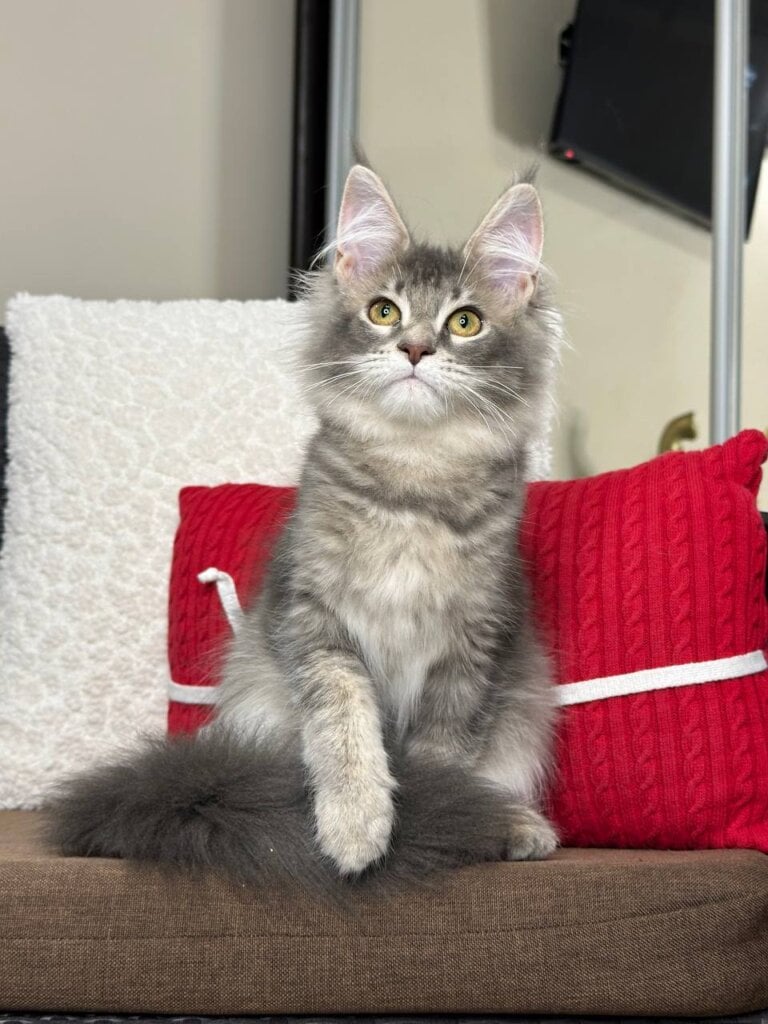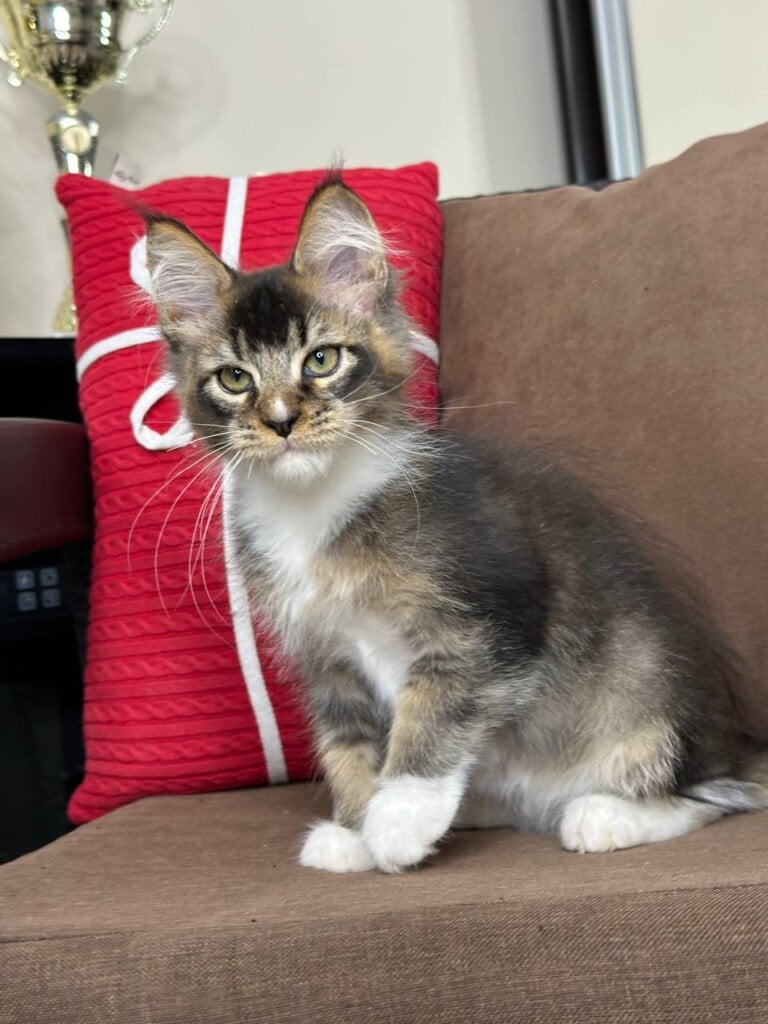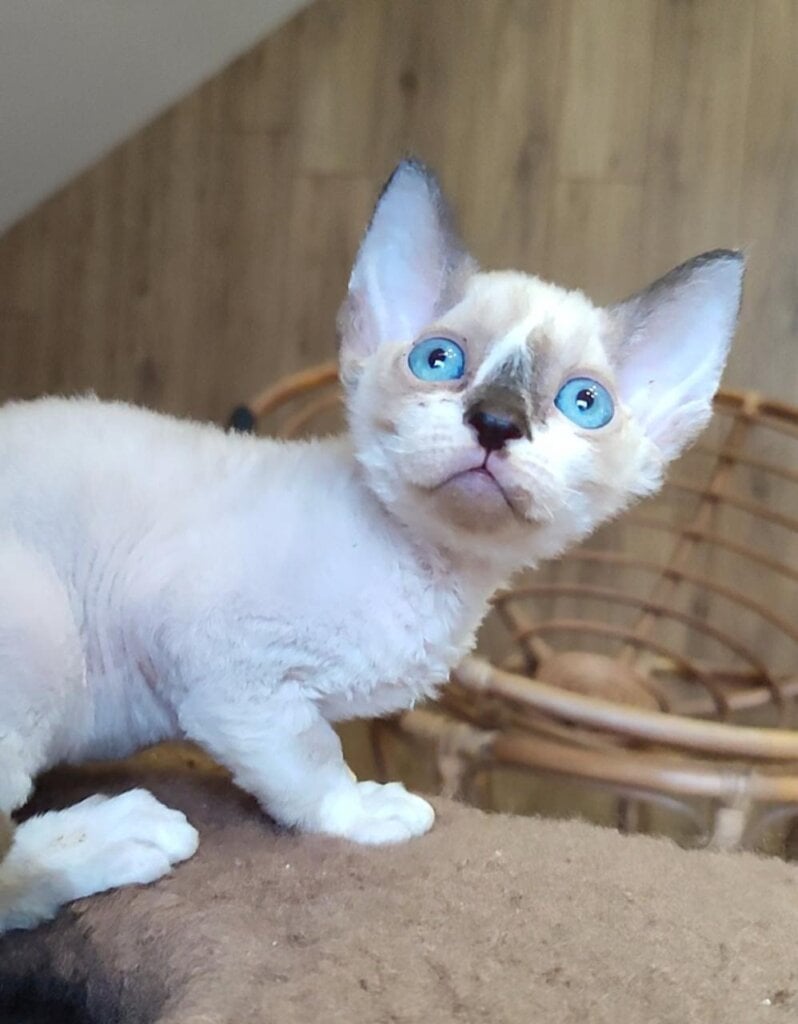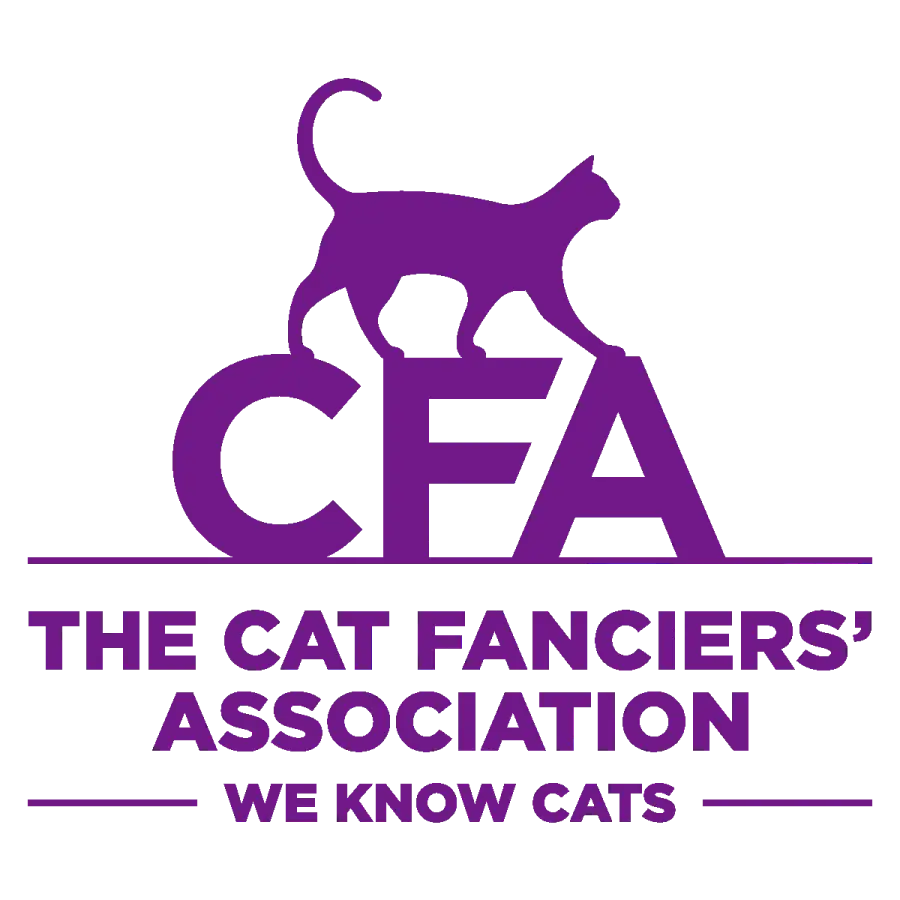Key Takeaways
- A Maine Coon growth chart is an essential tool for monitoring your cat’s progress. It helps determine whether they are hitting developmental milestones for their age and growing as they should be. It prevents us from tracking their progress with confidence.
- Whether it’s a child, a kitten, or a puppy, routinely utilizing a growth chart allows us to monitor key health indicators such as weight, height, and length. Regular examinations will help identify any troubling patterns and promote their health and well-being.
- Growth charts allow us to detect problems as early as possible. By detecting issues such as stunted growth or unusual weight gain/loss, we can act quickly and collaborate with a veterinarian to make the necessary changes.
- Maine Coons tend to grow in bursts, with most of their rapid growth occurring as kittens and then reaching their full size around 3-5 years. Being cognizant of these development phases allows us to deliver proper lifestyle care and nutrition, tailored to the different developmental stages.
- Genetics, diet, gender, and environmental factors all contribute to how quickly or slowly a Maine Coon will grow. We can fine-tune these to help make sure our cat grows up strong and healthy.
- Consistently measuring an animal’s length, height, and weight and documenting the measurements goes hand in hand with having an up to date growth chart. This allows us to better tailor their diet and care to their individual needs and make informed, data-based decisions.
What is Maine Coon Growth Chart?
A Maine Coon growth chart is a helpful tool for understanding the typical development patterns of this beloved cat breed. Maine Coons, both for their prodigious size and their gentle disposition, have become popular pets. Unlike other domestic cats, they grow in a much slower manner, which is what makes them so unique.
Since most cats are considered full adults by the time they turn 1 year old, the answer is no. On the other hand, Maine Coons continue growing and don’t reach their full size until they’re four years old. This longer growth period means it’s crucial to track their growth to provide them the right care to keep them healthy.
A high-quality diet is vital in ensuring your Maine Coon grows at the appropriate rate. With the right nutrition, they can achieve their size potential. Besides that, it encourages a shiny coat, robust bones, and high energy levels.
When they reach one year old, Maine Coons will have reached around 80% of their adult weight.
Males usually weigh anywhere from 10 to 15 pounds. On the other hand, females typically weigh between 10 and 15 pounds. Males tend to be taller on average. In reality, measures fluctuate greatly as a result of genetics and environmental conditions.
To get an accurate height measurement, ensure the cat is standing on all fours. This positioning allows for the most repeatable and accurate read.
Genetics play an enormous role in determining a Maine Coon’s growth rate and final size. Responsible breeders focus on long-term health and good temperament rather than extreme sizes. They follow extreme guidelines set forth by regulating agencies such as TICA to the point of sacrificing a cat’s health and life.
Though Maine Coons are famous for being the largest domestic cat breed, their charm goes beyond just their impressive stature. It’s their affectionate and playful nature that makes Maine Coons a truly cherished addition to any family.
To get the complete picture of a Maine Coon’s growth journey, it’s important to keep track of their weight and height over time. This method is useful in making sure they’re growing at a normal rate.
Continuously monitoring their growth and ensuring they receive appropriate veterinary care and attention allows these colossal beauties to flourish in their forever homes. They provide unparalleled companionship and joy for decades to come.
Why Use a Growth Chart?
Keeping a Maine Coon growth chart as a new pet owner marker is an essential step for a responsible owner. These mighty felines are known for their impressive stature and placid nature. Their special growth patterns usually develop over a three- to five-year time period.
A growth chart is the only tool we have to diagnose what’s going on. It means making sure everyone is moving in a healthy direction at each stage of life. By recording measurements like weight, height, and length, we gain valuable insights into their overall well-being and can provide the best care tailored to their needs.
Track Developmental Milestones
Timing Maine Coons grow at a much slower rate than most other cat breeds. By the time they celebrate their first birthday, they have usually attained around 80% of their adult weight. Their complete growth doesn’t wrap up until deep into their third – perhaps even fifth year.
The best way to document these milestones is to use a growth chart. We can monitor their consistent weight gains and see the changes in their height and length in real time. A male Maine Coon should weigh around 3 lbs at three months. By the end of its first year, it can weigh almost 15 pounds.
Tracking these benchmarks helps us celebrate their progress and ensures that their growth aligns with what is expected for their breed and age.
Monitor Overall Health
A Maine Coon growth chart provides a clear picture of their overall health. Regularly updating the chart with their measurements allows us to assess whether their diet and care are supporting healthy development.
For example, if a kitten’s weight gain slows significantly after six months, this could indicate nutritional gaps or other concerns. By having these records, we can make informed adjustments, whether it’s optimizing their diet or consulting a veterinarian.
A personalized growth chart considers age, sex, and breed, creating a tailored approach to their care.
Identify Potential Issues Early
Timely recognition of growth cessation or abnormalities in the growth plate is paramount. Finally, if your Maine Coon’s growth falls far outside of the expected range, it may be a sign of health issues.
These could be things like hormonal issues or genetic syndromes. By spotting these indicators ahead of time with regular charting, we can pursue veterinary guidance and best address their needs proactively.
This proactive approach gives our cats the best chance to succeed, so they can be the best versions of themselves – both physically and emotionally.
Key Features of Growth Charts
It is important to understand a Maine Coon growth chart to better track your Maine Coons development and maintain your Maine Coons good health. These charts provide important information about where your kitten is on their growth journey. Harness this knowledge to champion their one-of-a-kind growth story!
Read on as we unpack the most important features of Maine Coon growth tracking to give you a full picture.
1. Age-Based Expectations
Maine Coons mature at a slower rate than other felines, their growth lasting several years. In the newborn stage (0-4 weeks), kittens are tiny and helpless, only able to nurse and build strength.
Around 8-12 weeks, the juvenile stage starts, characterized by super-fast growth and curiosity about the world around them. Adolescence takes place from 12-24 weeks, during which time Maine Coons go through rapid physical and behavioral development.
By 24 weeks and at 28 weeks they’re starting to move towards adult expectancy. Just like children, they don’t usually grow into their full size until they’re 4 – 5 years old. Each development stage has distinct milestones and the ability to track them as we age is a hallmark of good care throughout our lives.
2. Expected Weight Ranges
Weight is the easiest and most common measure of healthy growth. Maine Coon kittens will average 1-2 lbs of weight gain during their first 12 months. This growth rate is three times faster than that of any other breed.
Adult males usually weigh from 15-25 lbs and adult females weigh from 10-15 lbs. By weighing your cat at the same time each week, any changes or deviations will be noticed quickly, keeping your cat on course toward their anticipated size.
3. Stages of Development
Beyond weight, monitoring general size – length, height, and body fat or muscle mass – is crucial. The average Maine Coon would measure approximately 40 inches in length and up to 16 inches in height.
Given their slow maturation process, growth charts should ideally cover multiple years. This longer time frame gives you the ability to track important milestones, from precocious kitten to powerful adult cat.
4. Gender-Based Differences
Note that males and females grow in different ways. Or perhaps because males tend to be larger and have a more marked growth spurt while females tend to have a more constant growth rate.
Understanding and adjusting your growth chart for these differences allows you to provide accurate, tailored care.
5. Important Health Metrics
Monitoring changes in weight, length, and height in tandem with developmental milestones and presence of health conditions is key. Spaying or neutering, for example, can play a role in a cat’s growth rates, sometimes spurring a temporary growth spurt.
By keeping up with regular monitoring, you can catch and correct issues before they develop into larger concerns.
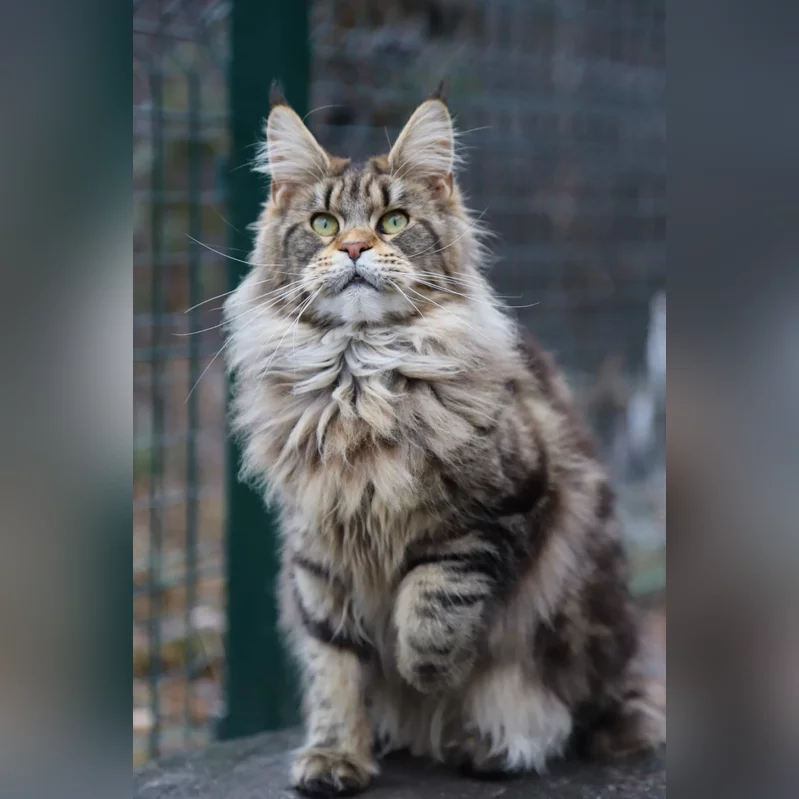
How Quickly Do Maine Coons Grow?
Maine Coons are special even among domestic cat breeds for their astonishingly large size and long puberty. Unlike most cats that take a year to reach their full size, Maine Coons continue growing into their third year. It’s really interesting to see their growth happen right before your eyes! Here’s a look at how Maine Coons grow, step by step.
1. Kittenhood (0-3 Months): Foundations
The first 90 days in a Maine Coon’s life should be taken seriously. In this phase, they go through a period of accelerated growth in both height and weight, setting the stage for their adulthood size. A newborn Maine Coon kitten usually weighs between 0.2 to 0.4 pounds.
By the end of this time, they may be 2 – 3 lbs. At this stage of growth, they begin to grow their trademark characteristics, such as tufted ears and their iconic bushy tail. These characteristics remain much more subdued than in their adult shape. Their nutrition and care at this stage is crucial, as they’ll be developing their skeletal and muscular frames.
2. Growth Phase (3-6 Months): Rapid Gains
From 3 to 6 months, Maine Coons go through a very quick growth stage. In general, males will grow faster than their female counterparts at 1-2 pounds of weight per month. This can result in a significant size disparity between the sexes.
At around six months, males typically range from 8 pounds to 12 pounds. Females are generally smaller, often weighing 6 to 10 pounds. It’s in this period that their long legs and lanky body really make an impression. This skinny look foreshadows the majestic felines they’re soon to become.
Due to their playful energy and curious nature reaching its prime, this is a specially fun time for an owner to connect with their cat.
3. Adolescence (6-12 Months): Shaping Up
At 6 to 12 months old, Maine Coons start to fill out, gaining length and muscle tone. Their growth rate during this phase slows down a bit versus the previous phase, but the growing doesn’t stop. By their first birthday, male pups usually reach 12-15 lbs.
In comparison, female puppies typically weigh 8 to 12 pounds. Even though they can look grown at this point, Maine Coons are definitely not done growing. Their luxurious fur coat grows even thicker and more pronounced, flaunting their fantastic mane-like look.
4. Young Adulthood (1-3 Years): Filling Out
After one year, as they enter young adulthood, growth in Maine Coons becomes much more steady and less drastic. This period is characterized by rapid weight gain and muscle growth. Adult males as a rule weigh anywhere from 15 to 20 pounds, and some may even reach close to 25 pounds.
By comparison, females typically weigh between 10 and 15 pounds. Their broad chest and muscular build starts to form, giving them the royal and powerful appearance they are so well known for. This stage emphasizes the breed’s slow maturing process, as they are still growing into their large frame.
5. Maturity (3-5 Years): Full Size
Maine Coons are one of the slowest-growing cat breeds, as they take 3 to 5 years to be fully mature in size. By now, their growth has nearly leveled out. Others, especially males, will keep putting on size until they are 5 or 6 years old.
Males average in weight at 18 to 25 pounds and females average between 10 and 15 pounds. At around 3 years of age, their height, length, and overall proportions all majorly solidify, making way for their majestic and commanding presence.
This long growth period allows plenty of time for their muscles and bones to develop. Because of this, they tend to grow into strong, healthy adult cats.
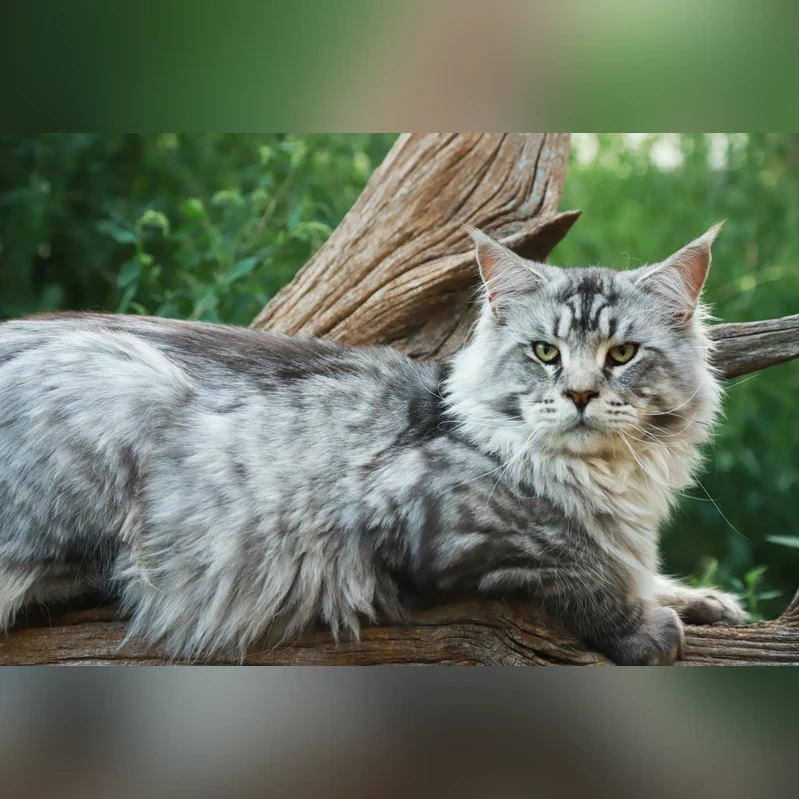
Average Maine Coon Weight by Age
With their large enough to be dog-like physical presence and appealing furball faces, Maine Coons are hard not to love. Knowing their growth stages is key to knowing how to care for them to facilitate proper development and growth. Unlike most breeds, Maine Coons reach maturity at a much slower rate.
Unlike other breeds, who fill out at age 1, Maine Coons need a little more time, taking an average of 4-5 years to reach their full size. Their slower rate of development gives them a distinctive quality compared to other breeds, one that demands special attention to their diet and general health as they mature.
The first year of life is by far the most active growth period for Maine Coon kittens. Around the six-month mark, these youngsters usually weigh anywhere from 10 all the way up to 12 pounds. This is due to the fact that their muscles and bone structure are still growing!
Now is a particularly important time to support their growth with a quality kitten diet. After that point, a high-quality diet of mostly full-formula dry kibble – with meals for kittens and pregnant mothers – is suggested until 1 year of age. This helps provide the key nutrients they need for energy, healthy muscle growth and a strong immune system.
Don’t forget that Maine Coons can weigh a lot at 6 months. One major reason for that is because, unlike most other cats, they continue growing and adding size well into adulthood!
As they approach their first birthday, Maine Coons generally weigh around 15 to 18 pounds, depending on individual factors like genetics and overall health. That’s not the end of their growth. Maine Coons are among the slowest growing cats.
Due to their large size, it can take them 3 to 5 years to achieve their full weight and height. Adult weight By the time they mature, male Maine Coons usually weigh between 15-25 lbs and females weigh 10-15 lbs. Since they experience a slower growth rate than most cats, their diet and all-around care must be adjusted to accommodate this longer developing stage.
After Maine Coons finish the juvenile stage at 24 weeks of age, their physical development stops growing and begins to taper off. After this, they hold the weight of fully grown cats. Careful attention to their body condition score and cater their meals with a high-quality, breed-specific food continues to be vital to help them flourish.
Factors Influencing Maine Coon Size
Maine Coons are one of the largest domesticated cat breeds and are often called the “gentle giants” of the felines. Still, their overall size and growth are determined by a multitude of factors. Being informed about these factors is key to fostering healthy growth and ensuring your Maine Coon matures into a majestic giant.
Genetic Predisposition
Genetics plays the largest role in influencing a Maine Coon size, making up about 70% of their size. The sizes of the parents give a good indication of just how big a kitten will get. For one, if both parents are on the larger side, the kittens have a higher likelihood of being large.
Males commonly will weigh between 15-25 lbs, with females averaging around 10-15 lbs. Mixed Maine Coons tend to be smaller than purebred Maine Coons. This discrepancy in size occurs due to the fact that their gene pool often incorporates characteristics of other breeds.
Some genetic lines are intentionally bred towards larger frames, which can be a determining factor when adopting.
Nutritional Impact
Nutrition is the other important factor in that other 30% of a Maine Coon’s growth equation. A proper diet full of premium proteins, healthy fats, and key nutrients helps nourish their healthy bone growth and strong muscle development. Foods designed for large breeds or active adult cats are especially helpful.
For one, making sure they have enough omega-3 fatty acids helps support joint health through their development. Bad nutrition can inhibit a Maine Coon’s growth and lead to weight problems. This wreaks havoc on their size and health.
Gender Variations
Gender contributes to size differences. Male Maine Coons generally grow larger, with more robust and muscular builds compared to females. Their larger frame and stronger musculature often make males heavier, averaging 3-5 pounds more than their female counterparts.
While females are slightly smaller, they maintain the breed’s signature sturdy and long-bodied appearance.
Environmental Conditions
Environmental factors, like their activity levels and overall living conditions, play a significant role as well. This breed is naturally rambunctious, and daily interactive playtime or exercise will help promote proper muscle growth.
Temperature, amount of stress, and if they are kept indoors or outdoors may quietly affect metabolic rate. These environmental factors, in turn, influence weight and overall size throughout the cat’s life.
Measuring Your Maine Coon’s Growth
Measuring your Maine Coon’s growth will give you crucial information about their health and development. A Maine Coon growth chart would consist of weight, height, and length measurements, taken regularly during the kitten stage into adulthood. These cats come of age slower than other breeds, not fully-grown until about three to five years. Consistent measurement will give you insight into their progress and show you that they’re doing healthy and well.
What You’ll Need
To measure your Maine Coon accurately, you’ll need basic tools: a soft measuring tape, a pet scale, and a notebook or app for recording data. For height and length, a sewing measuring tape or fabric/tailor tape is perfect so you can bend it to their body’s curves. A digital pet scale will provide the most accurate weight measurements, which is especially important for kittens who can be quite squirmy.
Creating a patient, relaxed atmosphere enables the best, most accurate measurements possible.
Accurately Measure Length
For length, measure from the tip of your Maine Coon’s nose to the base of their tail. You can gently stretch them when they’re relaxed or propped up comfortably. Maine Coons are extremely long cats, often measuring 40 inches from the tip of the tail to head if grown to full adult size.
Measuring length every month while still a kitten will help you track their growth rate.
Accurately Measure Height
Height should be measured when your cat is standing in their natural posture on all four feet. To get their height, measure from the ground to the highest point of their shoulder blades, or “withers.” Maine Coons come with the mighty claim of being the largest domestic breed, but each furry fella is unique.
By following this process every time, you create a reliable method that allows you to monitor their individual growth pattern.
Accurately Measure Weight
For weight, invest in a digital pet scale. If your bathroom scale is large enough, you can set your cat down on it. Unlike other breeds, Maine Coons are unusually large and heavier. On average, male Maine Coons weigh 15 to 25 pounds and females 10 to 15.
By the end of their first year, however, they usually are about 80% of their adult weight.
Consistently Record Measurements
Maintain a regular routine. Monthly tracking throughout the kitten stage and regular monitoring as they grow into adults will give you a better picture of their growth. By contrasting your data with a Maine Coon growth chart, you can identify trends and take action to soothe any worries before they escalate.
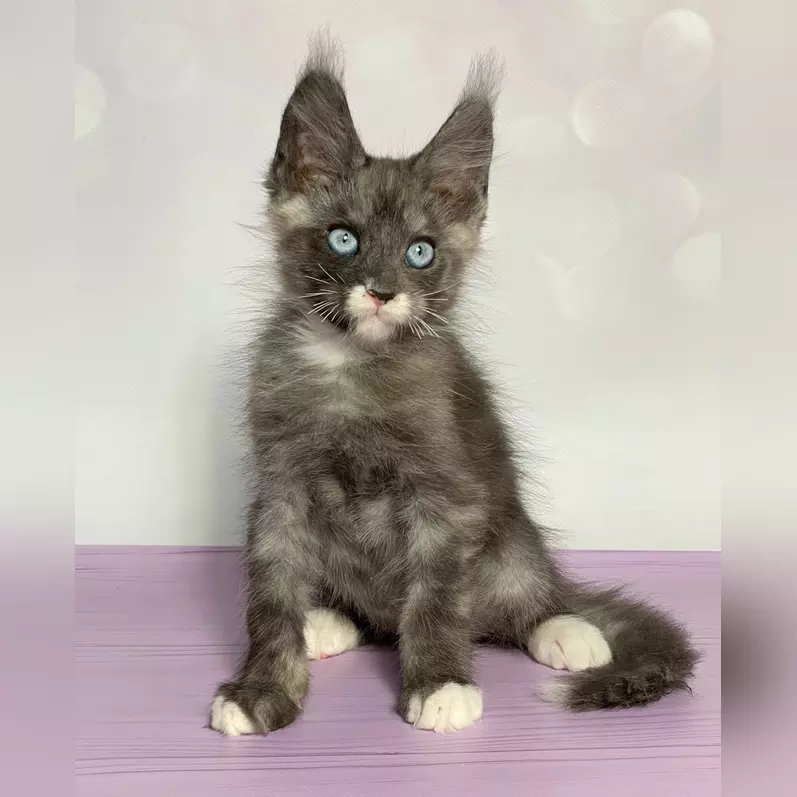
Dietary Needs for Optimal Growth
Maine Coons are mostly known for their remarkable size and muscular build, good nature, and intelligence. To foster their rapid and often selective growth and development, more importantly to support their long-term health, their dietary needs must be paid special attention to. Ensuring an adequate dietary balance of nutrients throughout all stages of life supports healthy growth.
It furthers the goal of eliminating obesity and related joint stress which is another widespread health problem. Let’s look into their dietary needs according to their life stages and other factors.
Kitten-Specific Nutrition
As young cats, Maine Coon kittens are growing quickly and their nutritional needs are different than those of an adult cat. A nutrient-dense diet that emphasizes high-quality proteins and fats is crucial to fuel their growing muscles, bones, and active imaginations.
Opt for kitten-specific formulas and find one that lists chicken, turkey, or fish as the first ingredient to provide those essential proteins to grow your kitten. These ingredients help deliver the amino acids that your pup needs in order to grow up and develop a robust immune system.
Regular feedings are essential at this time, since kittens have tiny tummies but big appetites. By feeding them at least three to four times a day, you help deliver constant energy to keep up with their on-the-go lifestyles.
Other vitamins and minerals like calcium and phosphorus are key nutrients for healthy bone development. Look for these nutrients in their food or speak to your veterinarian about supplementing them.
Adult Maine Coon Diet
As Maine Coons grow older and move into adulthood, their dietary needs should shift to suit their need for keeping up those big, muscular bods. Adult Maine Coons do best on a rich, well-rounded diet with protein, healthy fats, and low carbs.
Obesity might be a concern with over 10% fat, as limitation of fat is important above all because Maine Coons often have weight-related joint problems. Underfeeding leads to deficiencies – which can manifest in dogs’ coats, energy levels, and overall health.
Establishing daily portion control to avoid overfeeding is a challenge faced by close to 60% of U.S. Pet cats. Additionally, pairing their diet with regular exercise helps maintain their overall physical health.
Movingly designed play experiences, interactive toys, and climbing structures foster movement, helping kids build muscle, stay healthy, and maintain a healthy weight.
Supplement Considerations
A well-formulated, complete, and balanced commercial cat food will typically provide everything Maine Coons need to thrive. Nonetheless, many of these kitties could stand to have more supplements.
Omega-3 fatty acids, for example, help keep pets’ coats shiny while reducing inflammation, including that which affects their joints. Digestive Support – Probiotics are helpful in promoting a healthy digestive tract, especially when switching diets.
However, supplementation should always be approached with a veterinarian’s guidance to avoid unnecessary or excessive additions.
Maine Coon Growth Compared to Others
Maine Coons are big cats, and they make a big first impression. What makes Maine Coons different? Their unusual growth patterns distinguish them from other domestic cat breeds as well. Running alongside their growth story, is the equally intriguing and sometimes contradicting journey that is their genetics and breed influences.
Knowing what to expect in their growth and development enables us to give them the best possible care during their very long growing up period.
Comparing to Other Large Breeds
When compared to just about any other large breed, Maine Coons are unique for their extended growth period. For comparison, most domestic cat breeds stop growing at a year to a year and a half. Maine Coons continue to grow until they reach 4 years old. This longer growth period demands an ongoing commitment to their evolving nutritional and developmental needs.
Whether they’re growing or showing, you’ll want to give these magnificent beasts a top-notch diet. A diet high in protein and other key nutrients will accompany their slow, steady growth.
Fully grown male Maine Coons usually weigh from 15 to 25 pounds. For comparison, females weigh between 10 and 14 pounds. To provide you with some perspective, other large breeds like Ragdolls or Norwegian Forest Cats usually weigh 15 to 20 pounds for males. Females typically fall within the range of 9 to 13 lbs.
That difference illustrates just how large the Maine Coon really is, renowned as one of the biggest domesticated cat breeds. Additionally, Maine Coons have a longer average lifespan of 12.5 years or more, which is above the average for most other breeds. As big as Maine Coons are, their growth is downright amazing.
To sustain and carry around that kind of body takes some serious genetic fortitude, as well as lifelong care and attention.
Unique Growth Characteristics
Maine Coons have a distinct growth pattern that includes fast initial development with a prolonged, even growth stage. Like all kittens, they go through growth spurts during their first months of life, particularly between 3 and 5 months, which diminishes noticeably at around 9-12 months. Others do not stop growing, though more gradually, even into their fourth year.
This slow development is genetically determined and plays a part in their powerful stature and unique largeness. Maine Coons are hardy, resilient cats, but they are still prone to a few illnesses. One of these is hip dysplasia, which can occur from 3 months to 5 years old.
Routine veterinary checkups and close monitoring of their body condition score can reduce these risks. Their gentle and loving temperament is reflected in their playful behavior. They do best in households that can provide stable care and stimulation during their long maturation process.
